
Edward Wells, A New Map of the Most Considerable Plantations of the English in America, Oxford, England, 1700–1730. Engraving with watercolor on paper. 13 11/16" x 18 5/8". (Courtesy, Historic Deerfield, Inc., Albert and June Lauzon Collection, gift of Mrs. June Lauzon.)
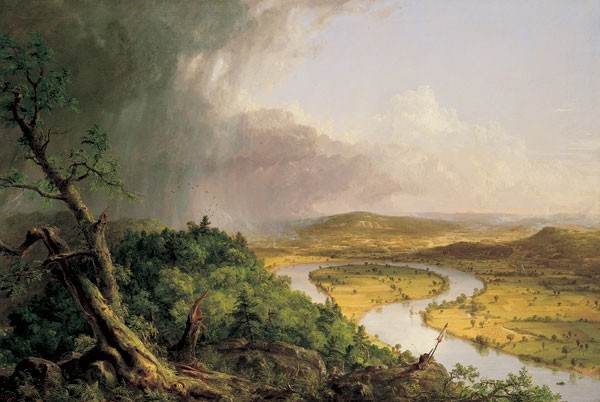
Thomas Cole, The Oxbow, 1836. Oil on canvas. 51 1/2" x 76". (Courtesy, Metropolitan Museum of Art, gift of Mrs. Russell Sage, 1908.)
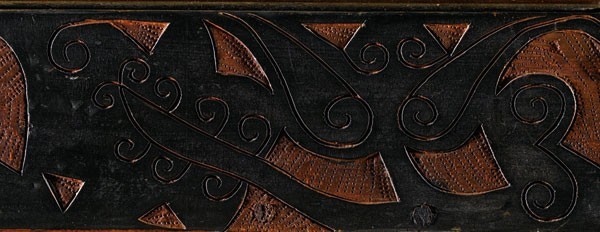
Detail of the tulip-and-leaf decoration on the chest illustrated in fig. 5. (Photo, Gavin Ashworth.)
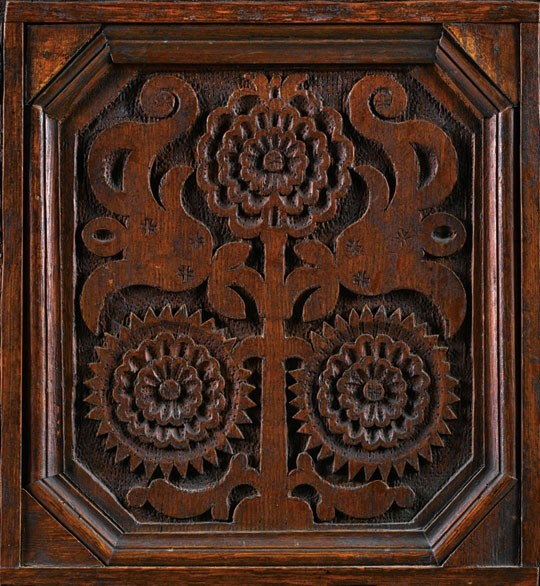
Detail of the carved center panel of the chest illustrated in fig. 63. (Photo, Gavin Ashworth.)

Chest, Hatfield or Hadley, Massachusetts, 1715–1720. Soft maple, chestnut, and oak with white pine. H. 44 3/4", W. 45 5/8", D. 19 7/8". (Courtesy, Historic Deerfield, Inc., gift of Dr. Ogden B. Carter Jr.; photo, Gavin Ashworth.) The paint is not original.
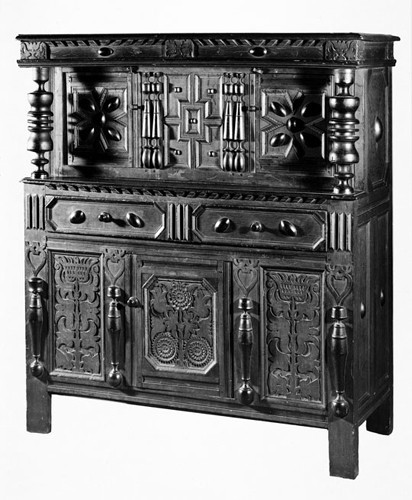
Cupboard, Hartford County, Connecticut, ca. 1680. Red oak, white oak, white pine, cedar, poplar, and maple. H. 56", W. 49 1/4", D. 20 5/16". (Courtesy, Yale University Art Gallery, gift of Charles Wyllys Betts.)
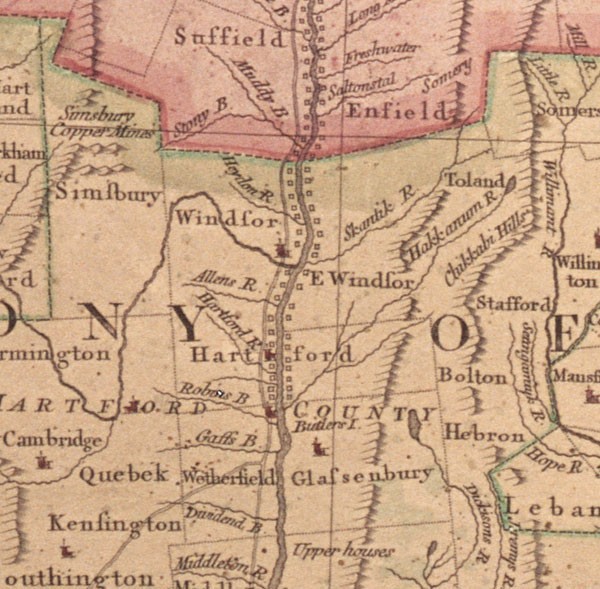
Detail of Tobias Conrad Letter, A Map of the Most Inhabited Part of New England, Augsburg, Germany, 1776. Engraving with watercolor wash on paper. 39 1/2" x 42". (Courtesy, Historic Deerfield, Inc.) This map was based on another map drawn by Braddock Mead (alias John Green) and published by Thomas Jefferys, London, 1755.

Detail of the map illustrated in fig. 1.

Embroidery patterns illustrated in Giovanni Andre Valvassore’s Esemplario di lavrio (Venice, 1552) and Giovanni Ostaus’s Vera perfettiono del desegno (Venice, 1557). (Private collection; photo, Gavin Ashworth.)

Elizabeth White, sampler, Hatfield, Massachusetts, before 1688. Wool on linen. 13 3/4" x 6 3/4". (Courtesy, Historic Deerfield, Inc.)

Chest attributed to Thomas Barber Sr., Windsor, Connecticut, 1640–1662. Oak with yellow pine and oak. H. 23 3/4", W. 54", D. 23 1/4". (Courtesy, Pocumtuck Valley Memorial Association, gift of Mrs. Catherine W. Hoyt; photo, Gavin Ashworth.) The stiles have been shortened and the lid and till are missing.
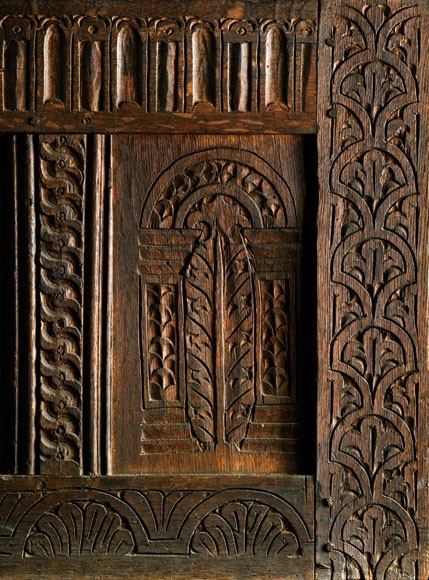
Detail of the carving on the façade of the chest illustrated in fig. 11. (Photo, Gavin Ashworth.)
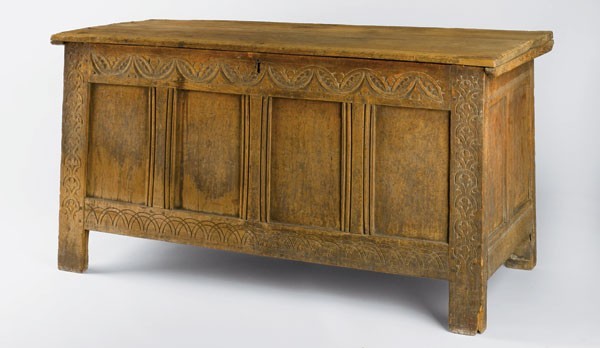
Chest attributed to Thomas Barber Jr., Windsor or Simsbury, Connecticut, ca. 1662. Oak with yellow pine and oak. H. 28 5/8", W. 55 1/2", D. 24 1/4". (Courtesy, Connecticut Historical Society; photo, Gavin Ashworth.)

Detail showing a spline used to join the lid boards of the chest illustrated in fig. 13. (Photo, Gavin Ashworth.)
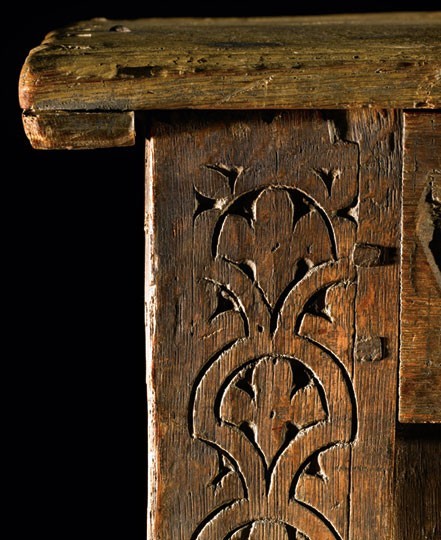
Detail of the carving on the left stile of the chest illustrated in fig. 13, showing the tessellated trefoil found in the same locations on all examples attributed to the Barber shop. (Photo, Gavin Ashworth.)
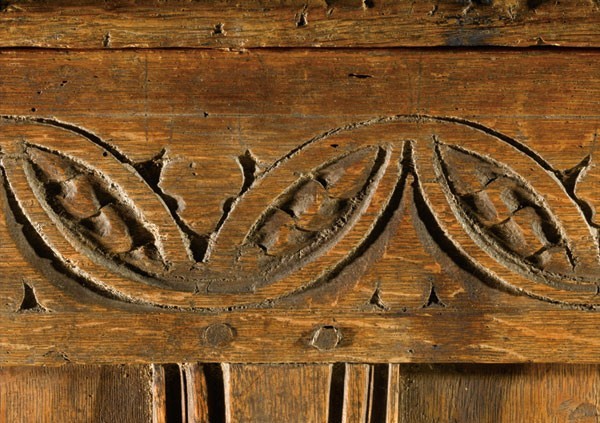
Detail showing the carving on the upper rail and molding on the muntins and lid of the chest illustrated in fig. 13. (Photo, Gavin Ashworth.)

Box attributed to Thomas Barber Sr., Windsor, Connecticut, before 1663. Oak. H. 4 3/8", W. 8 5/8", D. 5 1/4". (Private collection; photo, Gavin Ashworth.) The lock is missing.

Detail showing the waxed linen lining on the bottom board of the box illustrated in fig. 18. (Photo, Gavin Ashworth.)
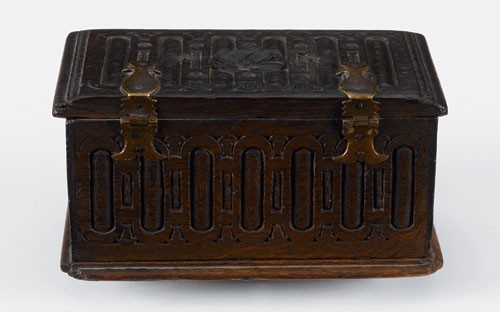
Back of the box illustrated in fig. 18. (Photo, Gavin Ashworth).
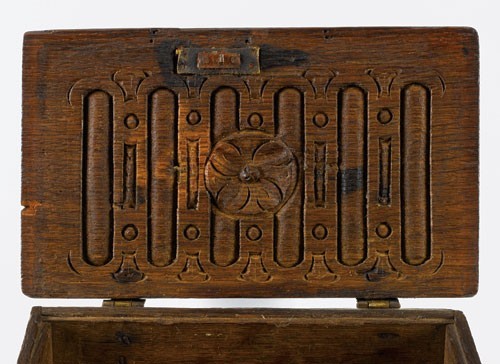
Detail showing the carving on the inner surface of the lid of the box illustrated in fig. 18. (Photo, Gavin Ashworth.)

Box attributed to Thomas Barber Sr., Windsor, Connecticut, before 1663. Woods and dimensions not recorded. (Wallace Nutting, Furniture Treasury, 2 vols. [Framingham, Mass.: Old America Co., 1928], 1: fig. 163.)
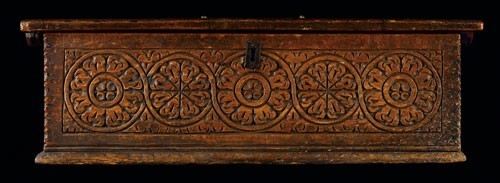
Box attributed to William Buell, Windsor, Connecticut, 1640–1681. Oak with pine. H. 8 1/2", W. 27", D. 18". (Courtesy, Oneida Historical Society, Utica, NY.)
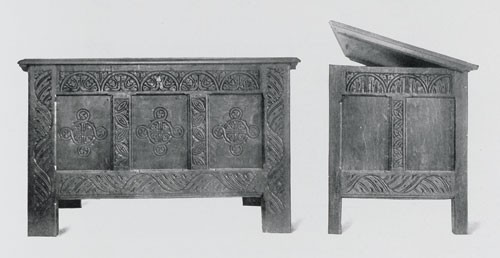
Chest, Windsor or Killingworth, Connecticut, ca. 1660. Woods and dimensions not recorded. (Luke Vincent Lockwood, Colonial Furniture in America, 2 vols. [New York: Castle Books, 1921], 1: 27, fig. 11.)

Box, Windsor or Killingworth, Connecticut, ca. 1660. Woods and dimensions not recorded. (Wallace Nutting, Furniture Treasury, 2 vols. [Framingham, Mass.: Old America Co., 1928], 1: fig. 158.)
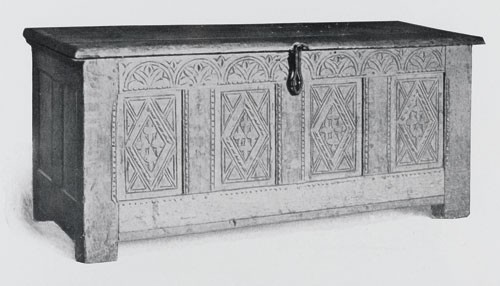
Chest, Windsor, Connecticut, before 1662. Woods and dimensions not recorded. (Luke Vincent Lockwood, Colonial Furniture in America, 2 vols. [New York: Castle Books, 1921], 1: 27, fig. 10.)
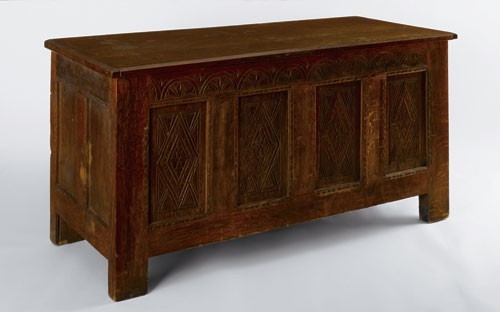
Chest, Windsor, Connecticut, ca. 1660. Oak. H. 24 1/2", W. 48 1/4", D. 19 3/4". (Private collection; photo, Gavin Ashworth.) The lid and floor boards are replacements.
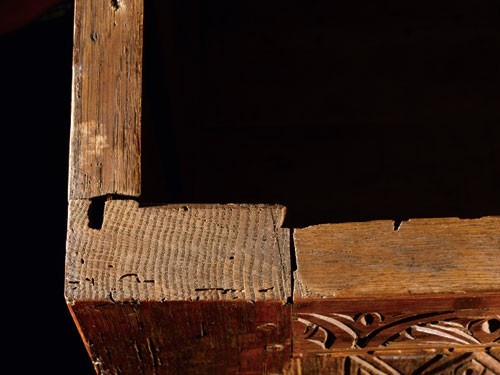
Detail showing the cross section of the left front stile of the chest illustrated in fig. 28. (Private collection; photo, Gavin Ashworth.)

Great chair, Windsor, Connecticut, ca. 1660. Oak. H. 47 1/2", W. 23 5/8", D. 17 3/4". (Courtesy, Museum of Fine Arts, Boston, gift of Aimee and Rosamond Lamb.) The feet, stretchers, and seat are replacements, and the paint is modern.
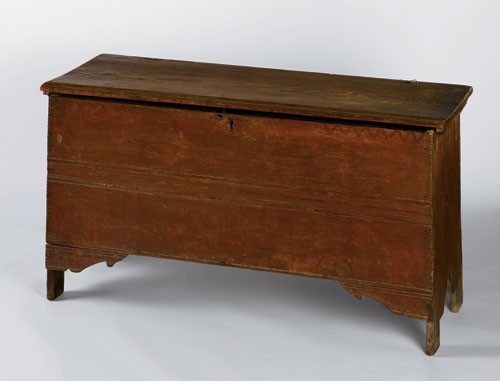
Chest attributed to John Rockwell III, Windsor, Connecticut, ca. 1700. Yellow pine and oak with yellow pine. H. 27", W. 49", D. 18". (Courtesy, Historic Deerfield, Inc., gift of Thomas C. Frary in memory of Margery Collins Frary.)
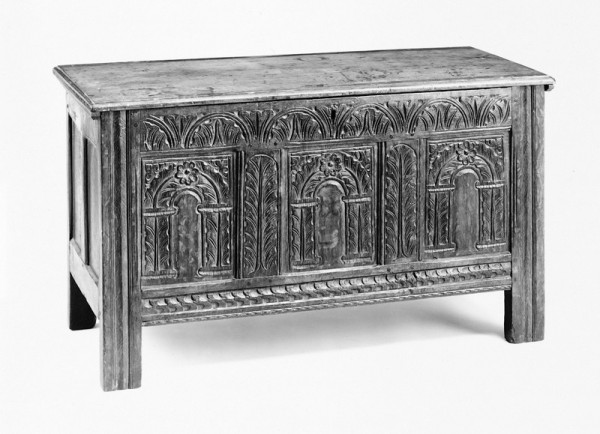
Chest attributed to John Rockwell I or John Rockwell II, Windsor, Connecticut, ca. 1660. Oak. H. 27", W. 48", D. 19 3/4". (Courtesy, Yale University Art Gallery, Mabel Brady Garvan Collection.) The white pine lid is a replacement.

Chest attributed to John Rockwell I or John Rockwell II, Windsor, Connecticut, ca. 1660. Oak. H. 26 1/4", W. 48 1/2", D. 20 1/2". (Private collection; photo, Gavin Ashworth.) The lid is a replacement.
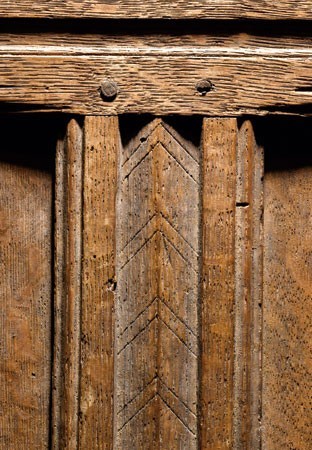
Detail of the chest illustrated in fig. 35, showing the angled convex molding and incised chevrons on the muntins of the façade.
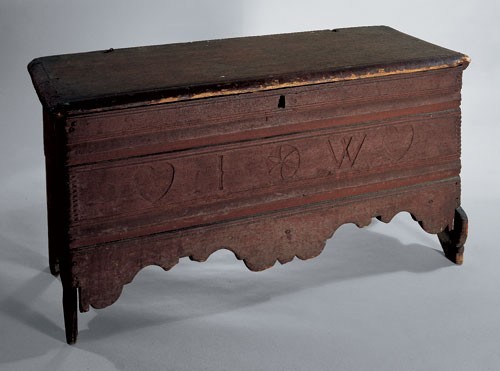
Chest, probably Hartford County, Connecticut, ca. 1720. Tulip poplar. H. 23", W. 46", D. 17 1/2". (Private collection; photo, Nathan Liverant & Son Antiques, Inc.)

Box attributed to John Moore I, Windsor, Connecticut, ca. 1670. Oak with yellow pine. H. 8 1/2", W. 29", D. 15 1/2". (Courtesy, Metropolitan Museum of Art, gift of Mrs. Russell Sage.)

Detail showing the notch cut in the upper inside face of the back board of the box illustrated in fig. 38.
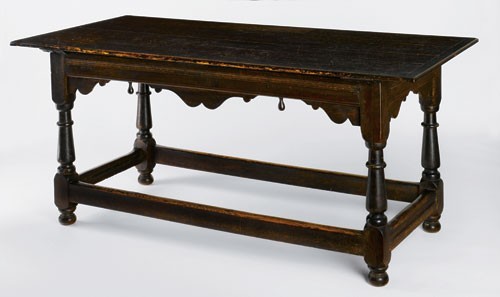
Table attributed to John Moore II or John Moore III, Windsor, Connecticut, ca. 1680. Oak. H. 31", W. 70", D. 32 3/4". (Courtesy, Connecticut Historical Society, gift of Harold G. Holcombe; photo, Gavin Ashworth.) The top, pendants, and most of the brackets are replacements.
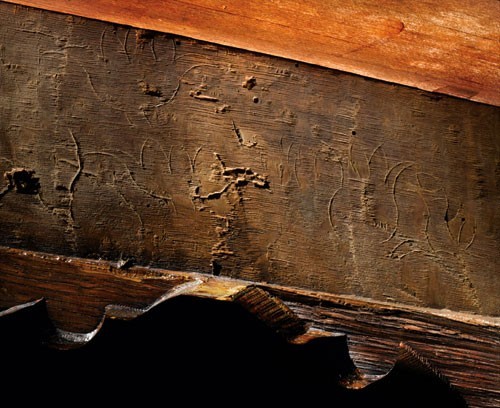
Detail of an end rail of the table illustrated in fig. 41, showing a flower head design laid out with gouge strikes. (Photo, Gavin Ashworth.)
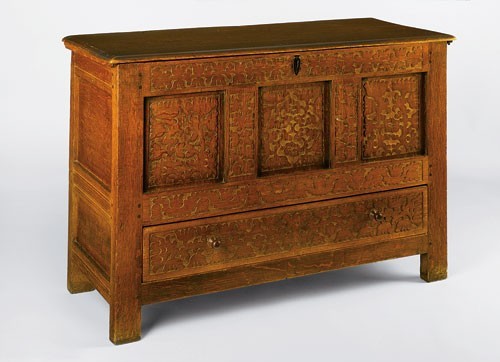
Chest attributed to Nathaniel Gaylord, Windsor, Connecticut, ca. 1680. Oak with yellow pine. H. 30 3/4", W. 46", D. 18 7/8". (Courtesy, Old Sturbridge Village; photo, Gavin Ashworth.)

Detail showing the layout lines and carving on the drawer and façade rails of the chest illustrated in fig. 43. (Photo, Gavin Ashworth.)

Chest, Windsor, Connecticut, ca. 1670. Oak with pine. H. 38 1/2", W. 44 3/4", D. 19 1/2". (Wallace Nutting, Furniture Treasury, 2 vols. [Framingham, Mass.: Old America Co., 1928], 1: fig. 11.)

Box, Windsor, Connecticut, 1670–1710. Oak. H. 8 5/8", W. 30 3/8", D. 15 7/8". (Courtesy, Windsor Historical Society, loan of Grace Episcopal Church.) The lid and bottom board are replacements.

Box, Windsor, Connecticut, 1670–1710. H. 9", W. 28 1/2", D. 15 1/4". Oak with pine. (Courtesy, Farmer’s Museum, Inc.)

Box attributed to Jacob Drake, Windsor, Connecticut, ca. 1680. Oak. H. 9 5/8", W. 24 4/1", D. 20 1/4". (Private collection; photo, Gavin Ashworth.) The hinges are replaced, and the paint may be a modern recreation of the original scheme.
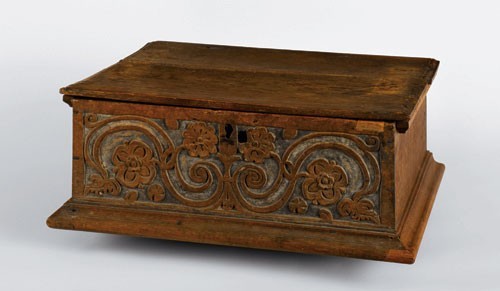
Box, Windsor, Connecticut, ca. 1670. Oak. H. 9 ", W. 241/2", D. 18 7/8". (Courtesy, Antiquarian and Landmarks Society, Inc.; photo, Gavin Ashworth.)

Box, probably Springfield, Massachusetts, ca. 1700. Oak with yellow pine. H. 9 1/4", W. 25 1/4", D. 16 1/4". (Courtesy, Historic Deerfield, Inc.; photo, Gavin Ashworth.)
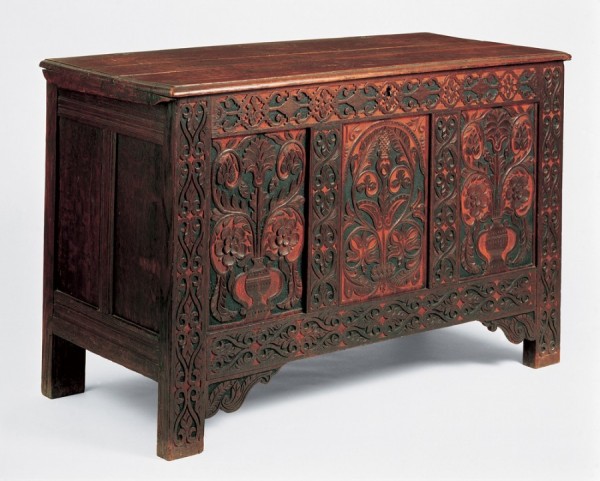
Chest attributed to Thomas Dennis, Ipswich, Massachusetts, 1676. Red and white oak. H. 31 11/16", W. 49 5/8", D. 22 5/8". (Courtesy, Winterthur Museum.)

Chest, probably Suffield, Connecticut, ca. 1730. Woods and dimensions not recorded. (Clair Franklin Luther, The Hadley Chest [Hartford, Conn.: Case, Lockwood & Brainard Co., 1935], p. 103, no. 62.

Chest attributed to Aaron Cook, Windsor, Connecticut, or Northampton, Massachusetts, ca. 1660. Oak with yellow pine. H. 28", W. 56 1/2", D. 20". (Courtesy, Historic Deerfield, Inc.; photo, Gavin Ashworth.) The drawer is missing.
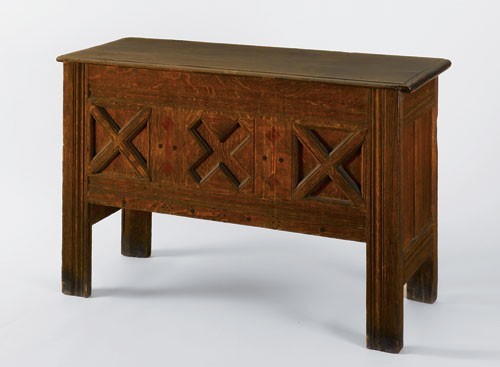
Chest, Windsor, Connecticut, or Hampshire County, Massachusetts, ca. 1680. Oak with yellow pine. H. 30 1/4", W. 47", D. 18". (Courtesy, Pocumtuck Valley Memorial Association, gift of James A. Reed; photo, Gavin Ashworth.) The drawer is missing.

Chest, Windsor, Connecticut, or Hampshire County, Massachusetts, ca. 1680. Oak with yellow pine. H. 30 1/4", W. 47", D. 18". (Courtesy, Historic Deerfield, Inc.; photo, Gavin Ashworth.) The lid and lock are replacements.
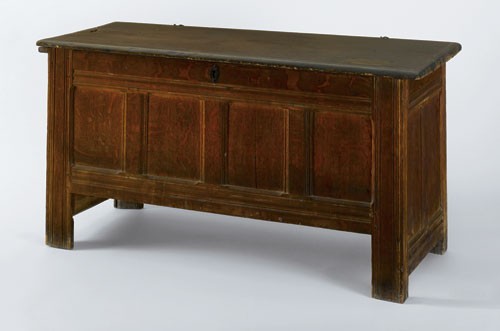
Chest, Windsor, Connecticut, or Hampshire County, Massachusetts, ca. 1680. Oak with yellow pine. H. 26 1/4", W. 51", D. 20 1/2". (Courtesy, Pocumtuck Valley Memorial Association, gift of Mary Wright Davis; photo, Gavin Ashworth.) The drawer is missing.
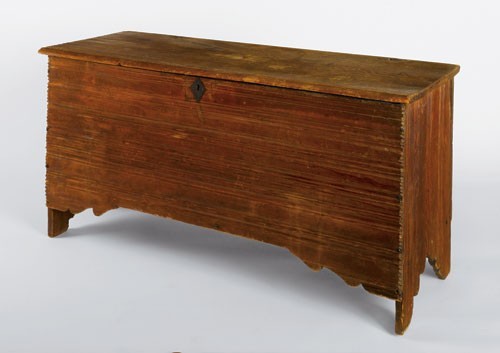
Chest, Windsor, Connecticut, or Northampton, Massachusetts, ca. 1680. Yellow pine. Dimensions not recorded. (Courtesy,
Antiquarian and Landmarks Society, Inc.; photo, Gavin Ashworth.)
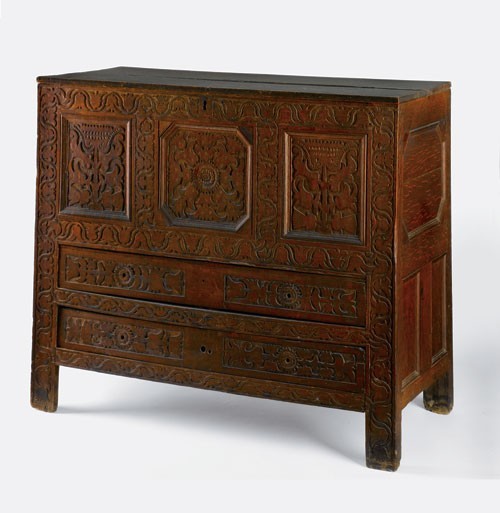
Chest attributed to Thomas Stoughton III or Thomas Stoughton IV, Windsor, Connecticut, ca. 1680. Oak with yellow pine. H. 39 1/2", W. 45 3/4", D. 19 3/4". (Courtesy, Connecticut Historical Society, gift of Thaddeus Mather; photo, Gavin Ashworth.)
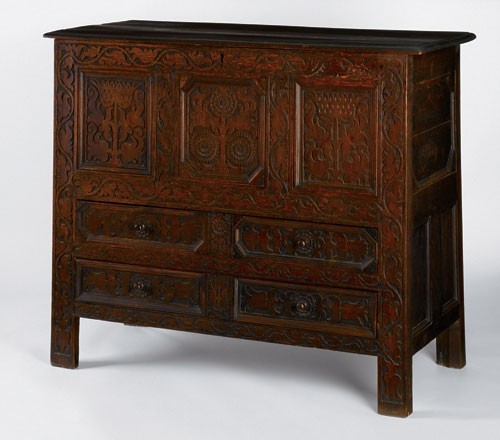
Chest attributed to Thomas Stoughton III or Thomas Stoughton IV, Windsor, Connecticut, ca. 1680. Oak with yellow pine. H. 41", W. 48", D. 20". (Courtesy, Historic Deerfield, Inc.; photo, Gavin Ashworth.) The lid has been altered.

Chest attributed to John Thurston, Dedham or Medfield, Massachusetts, 1660–1685. Oak with pine. H. 31 3/8", W. 47 3/4", D. 21". (Courtesy, Museum of Fine Arts, Boston.)
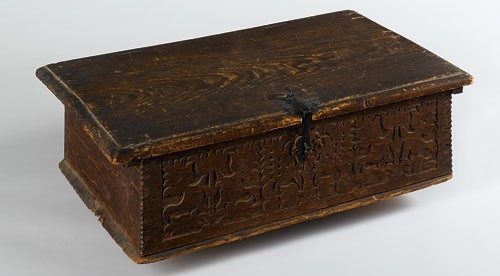
Box attributed to Thomas Stoughton IV, Windsor, Connecticut, ca. 1695. Oak and yellow pine with yellow pine. H. 7 1/2", W. 29", D. 17 1/2". (Private collection; photo, Gavin Ashworth.)

Detail showing the lid, cleats, and till of the box illustrated in fig. 66. (Photo, Gavin Ashworth.)

Detail of the carving on the box illustrated in fig. 66. (Photo, Gavin Ashworth.)
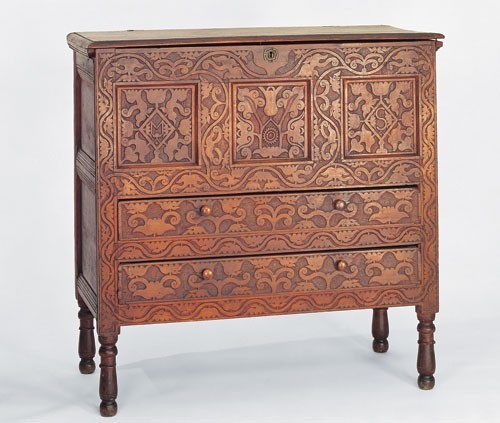
Chest attributed to Daniel White Jr., probably Hatfield, Massachusetts, ca. 1710. Maple with yellow pine. H. 45 1/4", W. 43 1/2", D. 19 3/4". (Courtesy, Wadsworth Atheneum, Wallace Nutting Collection, gift of J. Pierpont Morgan, by exchange and the Evelyn Bonar Storrs Trust Fund.)
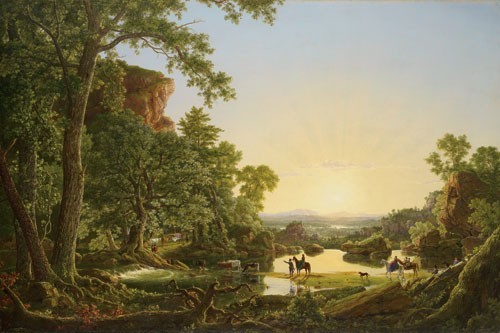
Frederic Edwin Church, Hooker and Company Journeying through the Wilderness, from Plymouth to Hartford, in 1636, 1846. Oil on canvas. 40 1/4" x 60 3/16". (Courtesy, Wadsworth Atheneum, Museum purchase.)
In 1614 Dutch adventurer Adriaen Block sailed up the Connecticut River, observing a fertile landscape of forests and floodplains dotted with settlements of Native Americans with whom he hoped to establish trade (fig. 1). Nearly two hundred years later Reverend Timothy Dwight, of Northampton, Massachusetts, traveled through the same region noting gardenlike farms and woodlots punctuated by the white spires of churches where Indian villages once stood. Whereas Block encountered an alien world of cultural difference, Dwight saw the Connecticut River Valley as an idealized arcadian vale peopled with pious citizen-farmers. In his posthumously published Travels in New England and New York (1821– 1822), Dwight observed that the “inhabitants of this valley may be said . . . to possess a common character.” Failing, or refusing, to recognize evidence of a society divided by class and racial distinctions, conflicted over access to, and uses of, the land and its resources, and exposed to the financial vagaries of an industrializing economy, he struck a nostalgic note in describing a world that never was. In 1836 Thomas Cole visually reinforced Dwight’s assessment in his landscape painting of the Connecticut River Valley of central Massachusetts, The Oxbow (fig. 2).[1]
As more recent historians of the region’s early history have found, the area’s first European settlers were more attuned to perceived ethnic, cultural, and religious differences than to any sense of “common character.” Slavery, warfare, and class divisions—expressed most starkly by the unequal distribution of land to the rich—and religious disagreements over such issues as ministerial authority and qualifications for church membership, cleaved inhabitants one from another in the first several decades of European settlement. First- and second-generation English colonists were as likely to move away from one another as a means of resolving conflict as they were to seek compromises to remain together in their original settlements. Yet, by 1650 arrival of settlers from outside the region had slowed to a trickle, and after 1680 mobility rates dropped, as the children and grandchildren of the region’s original settlers grew into adulthood, intermarried, and populated the region’s towns with families of their own. By the end of the seventeenth century, extended kin networks linked individuals in communities up and down the Connecticut River and gave shape to a collective “civic culture” among middle- and upper-class whites, characterized by what historian Robert Blair St. George termed “regional consciousness.”[2]
Inhabitants who participated in this “civic culture” manifested regional consciousness in their foodways, agricultural practices, social customs, and, more enduringly, the architecture of their houses and public buildings, gravestones, furniture, and other artifacts of material culture. Collectors and furniture historians have focused on approximately 220 case pieces with relief-carved tulip-and-leaf motifs made in towns from Suffield to Deerfield (fig. 3) and approximately 80 joined case forms decorated with relief-carved flower heads and applied half-columns, bosses, and moldings thought to originate in a Hartford County shop currently associated with Wethersfield woodworker Peter Blinn (1649–1725) (fig. 4) as material expressions of a uniquely American identity that emerged in the region during the late seventeenth and early eighteenth centuries (figs. 5, 6). Although much is now known about this furniture and its makers, little attention has been given to contemporary regional work that diverged from these traditions. Furniture made by craftsmen working outside these two groups raises important questions about the geographic contours of regionalism in the Connecticut River Valley and the development of regional identity over time. This study examines examples of furniture that several of the 215 woodworkers who lived and practiced their trade in Windsor made between 1635 and 1715 to address the following questions. What kinds of furniture did joiners working in the Connecticut River Valley’s primary woodworking center of Windsor, between Suffield and Wethersfield, produce? How did generations of Windsor woodworkers contribute to the development of a regional aesthetic? What did these joiners’ preferences in construction methods, decorative techniques, and designs suggest about their, and their clients’, assumptions concerning cultural propriety, craft proficiency, and self-identity?[3]
Much of the historiography of regionalism in the Connecticut River Valley explores the role that elites—acting in their overlapping capacities as public figures and private consumers—played as arbiters of taste. Some scholars have argued that furniture and other “artifacts of regional consciousness” were part of a dialectical exchange between elites and commoners. The elites sought to distance themselves from those of lesser wealth and status while maintaining their grasp on power by emphasizing their mutual interests with commoners. Commoners, for their part, resented and resisted the power of the elites at the same time that they sought to emulate them. In the Connecticut River Valley, wealthy magistrates, merchants, and ministers acquired furniture as props to create “a theater of dominance that separated them from their less wealthy neighbors” without alienating them. But what was the role of the craftsman in this ongoing drama? The lives and products of Windsor’s woodworkers reveal much about what furniture historian Edward Cooke has termed the “social economy” of the seventeenth-century Connecticut River Valley—the making and exchanging of household goods within a specific social context of family relations, barter, political favors, and patronage that the town’s woodworkers relied on in practicing their trades. Within this social economy, their furniture rose above the status of marginal props in a drama played out between elites and commoners and became constitutive of the very culture that defined both.[4]
Historical, Cultural, and Aesthetic Context
In the mid-1630s English colonists moving from earlier settlements in eastern Massachusetts established the towns of Wethersfield, Hartford, and Windsor in Connecticut and Springfield in Massachusetts (fig. 7). Although they came variously from all regions in England as merchant-adventurers, Indian traders, Puritan religious idealists, farmers, and craftsmen, they shared a single-minded ambition to own enough farmland to feed their families and produce marketable surpluses. The colonists who arrived in 1635 from an initial settlement in Dorchester, Massachusetts (fig. 8), were typical: they immediately set about the task of claiming the land and apportioning it to the male heads of households among them. What set the majority of Windsor’s settlers apart from those in the other three Connecticut River Valley towns were their interconnected family backgrounds in England, their circumscribed regional English origins, and their collective religious experience. As natives of towns and villages in England’s southwest counties of Devon, Dorsetshire, Somersetshire, and Wiltshire, all within a forty-mile radius of Dorchester, Dorset, many in this group had come to know one another as followers of charismatic Puritan preacher and colonial promoter Reverend John White (1575–1648), rector of Holy Trinity Church in Dorchester. In 1628 and 1629 White had recruited a dozen young single men and twenty-seven married couples with seventy-two children among them to establish a settlement in New England. Perhaps drawing on his experiences both in the rebuilding of Dorchester after a devastating fire destroyed the town in 1613 and in an earlier failed colonial project, White targeted craftsmen, particularly woodworkers, as critical to the success of his settlement.[5]
On the eve of their departure for Massachusetts in 1630, White helped his recruits covenant as an oceangoing congregation and presided over their installation of his young colleague Reverend John Warham (1595–1670) as minister. The group departed aboard the ship Mary and John on March 29, 1630, landed in Massachusetts Bay on June 14, then traveled overland to settle at Mattapan, the future site of Dorchester. By 1635 other newcomers, these from East Anglia, not only claimed land that members of Reverend Warham’s group had counted on for their own families but also clashed with them over politics and religion. These factors prompted Warham and many members of his original shipboard congregation to resettle in Windsor.[6]
On their arrival in Windsor, Warham’s congregation confronted two other groups with competing claims to the land. One group consisted of settlers from Plymouth Colony, who had set up an Indian trading post in Windsor’s Great Meadow bordering the Connecticut River. The other group included woodworkers whom the master carpenter Francis Stiles had hired to help fulfill a contract that English nobleman and colonial investor Sir Richard Saltonstall had negotiated with him to improve land that Saltonstall had been granted in Windsor. Members of the Dorchester group occupied the land surrounding the trading post and eventually bought out the Plymouth settlers’ interests in the venture. They also claimed the land Stiles had been sent to improve, obstructing Stiles and his workers and arrogating Saltonstall’s land for redistribution among themselves. Although they allowed Stiles and his workmen to remain in Windsor, they apparently relegated them to the margins of society. The Dorchester group had acted quickly to solidify their claims to the land and to define and dominate town government. Once assured of power, they set out to create a community grounded in their Congregationalist faith that, in their view, both corrected the social and economic ills that had followed passage of the Enclosure Acts throughout England and preserved traditional order and social hierarchy.[7]
Windsor’s settlers defined propriety and prosperity primarily in terms of land-ownership. In England, as much as 30 percent of the rural population had consisted of the landless poor, and so it was with added significance that Windsor’s inhabitants measured their success by the quality, type, and value of their acreage and by the houses, barns, outbuildings, pens, and fences that they erected on those lands. Through their acquisition of home lots, woodlots, fields, and pastures, Windsor’s freemen—resident, landowning male heads of households—provided not only for their families’ immediate wants but also for their sons’ future needs: their land represented their male heirs’ inheritances. However, they also prized material possessions. For the convenience and comfort of their large families, Windsor’s wealthier landowners furnished their homes with an assortment of housewares and textiles as well as boxes, chests, cupboards, tables, benches, chairs, bedsteads, and other wooden furniture made from sawn boards nailed together and from riven components assembled with mortise-and-tenon joints. These objects, especially textiles and furniture, represented movable wealth customarily willed to female heirs. Whereas these middling and wealthy farmers owned similar furniture forms, household inventories indicate that the wealthy both purchased furniture in greater quantities than their less-wealthy neighbors and commissioned a few expensive, stylish forms not seen in poorer neighbors’ homes, such as large oak cupboards, possibly decorated with moldings, carving, and turned columns in their upper cases. With case furniture constructed from durable oak and yellow pine, embellished with carved and painted surfaces, and secured with locks, Windsor residents symbolically set themselves apart from the poor landless whites they had left behind in England, from the Native Americans who had helped them through their initial years of settlement in Windsor, and from the “white Indians”—traders, hunters, landless vagrants—they occasionally encountered in the region. Case furniture fitted with locks and keys conveyed values of security, stability, and materialism that must have contrasted sharply with the impermanence and profligacy ascribed to poor whites, “white Indians,” and Native Americans.[8]
Windsor woodworkers used red and white oak as the primary material for joined case furniture. A single laborer working with a wedge, beetle, and froe could split all of the stock required for joinery, an important consideration since the town did not have a water-powered sawmill until 1687. Durable and resistant to rot and insect damage when dry, riven oak displays large transverse rays. This grain pattern satisfied the prevailing late Renaissance taste for woodwork with visually complex, patterned surfaces. Settlers accustomed to furniture constructed from English oak, which was usually of poor quality and mill-sawn to reduce waste, must have appreciated the vibrant pattern and superior grain of riven American variants. In a similar vein, Windsor furniture makers and their patrons evidently preferred yellow pine over less durable conifers and softwoods. Readily pit-sawn into clear, wide boards, yellow pine was well suited for lids, panels, drawer interiors, and board furniture. Its high pitch content may also have deterred insects, which would have been advantageous in furniture intended to store textiles.
Like English craftsmen elsewhere, Windsor’s woodworkers used oak for both practical and cultural reasons. Expressing ideas about wood that had been circulating in English culture since medieval times, Randall Holme noted that oak was “the strongest of Trees, . . . apt for mighty Buildings . . . [and] the emblem of Protection and Safety, Force, Strength, and long Life.” A wreath of oak leaves symbolized “Valour and safety . . . and therefore may not unfitly be termed the Garland of Honour and Protection.” Oak appeared as a literary conceit in other contexts, reinforcing and enlarging on the symbolic meanings Holme set forth in The Academy of Armory, or, A Storehouse of Armory and Blazon (1688). In his journal, Windsor woodworker Matthew Grant captured the text of a sermon that Reverend Thomas Hooker, minister at Hartford, Connecticut, delivered from the pulpit of Windsor’s church as a guest preacher, sometime in the 1640s. Drawing from Matthew 12:18–20, Hooker described “God’s children” as “bruised reeds before their conversion” and urged the unconverted in his audience to recognize their innately sinful natures—to “know themselves to be reeds and not oakes.” By contrast, Hooker compared the full church members in his audience to oaks. For the woodworkers whom Reverend John White had recruited to build a model community and Windsor’s Christian faithful, oak was a potent symbol of Puritan style and ideology. Literally it constituted the material from which plain-style furniture was made; rhetorically it served as a metaphor for the converted; and figuratively it evoked spiritual reflection.[9]
Oak was imbued with yet other meanings. It figures centrally in Aesop’s “The Oak and the Reed,” a fable that English antiquarian Philip Ayres included in his Mythologia ethica, or, Three centuries of Æesopian fables in English (1689). In this story, a stalwart oak is blown down in a gale while the humble reed survives unscathed. Ayres’s version repeated Aesop’s characterization of oak as rigid and inflexible, and further portrayed it as an ancient tree rooted in history and resistant to the winds of change. By 1689 riven oak furniture was quickly passing out of fashion in urban centers on both sides of the Atlantic. That Connecticut River Valley inhabitants continued to favor oak for furniture well into the eighteenth century attests to their selective attachment to and recycling of the past.[10]
Windsor furniture makers offered a variety of options including architectural moldings, painted decoration, and carving that merged the visual tradition of Britain’s pre-Christian past with Renaissance classical designs. Incorporating abstract geometric, architectural, and naturalistic imagery, this carving resembled and may have been inspired by printed textile design books that circulated throughout Europe beginning in the 1550s (figs. 9, 10). In the construction and decoration of their furniture, Windsor’s woodworkers attempted to fulfill their patrons’ expectations regarding workmanship, artifice, aesthetics, and symbolism. Acquired in the expectation that it would be handed down to later generations, this furniture provided its owners with a sense of continuity and community. Furniture rooted in regional English traditions reminded settlers of the Old World and, through ownership and inheritance, ramified connections with family living abroad and in the Connecticut River Valley. As historian Laurel Thatcher Ulrich has shown, material possessions, especially case furniture carved with the initials of their female owners’ maiden names, also denoted gender and lineage within the blended family lines that increasingly defined regional culture at the end of the seventeenth century.[11]
WOODWORKING TRADITIONS
Twenty-seven immigrant woodworkers plied their trade in seventeenth-century Windsor. Of the eight shop traditions that can be identified today, only a few persisted intact for more than three generations. Others disappeared more quickly as woodworkers created hybrid styles by combining traditional practices and designs with techniques and motifs that they learned while collaborating on public building projects and working for one another. The lives of the masters and the choices they made in practicing their trades determined their success as well as the influence their shop exerted on woodworking in the region. Furniture made by members of the Barber family offers historical insights into some of the factors that defined a shop’s place within the community and the wider network of woodworking shops spread across the region.
The Barber Shop
A joined, carved chest that probably belonged first to Nicholas Hoyt (1622–1655) may represent the work of Thomas Barber Sr. (1614–1662), a carpenter from Bedford, in the English Midlands (figs. 11, 12). Barber was not related to Hoyt by marriage, and since they immigrated with different groups, it is unlikely that they had encountered each other in England. The chest’s attribution is based on its close similarity to a chest that Barber’s son and apprentice Thomas (1644–1711) probably made for his father-in-law, cooper William Phelps (1599–1672), in 1663 or thereafter (fig. 13).[12]
Both chests have oak panels and framing members assembled with double-pinned mortise-and-tenon joints. The Hoyt chest has four back panels, whereas the Phelps chest has only three. The floor of the Hoyt chest is constructed in the same manner as that of the Phelps chest: the boards are oriented longitudinally, joined with a spline (a long, thin strip of wood slotted into grooves on the boards’ inner edges), and set into grooves in the stiles and all four lower rails. Both floorboards of the Hoyt chest are composed of pit-sawn yellow pine. The floor of the Phelps chest has a single pine board at the back and a pit-sawn oak board at the front. The size and grain of the oak board suggest that the maker cut it from the same log as the lid. Although the original lid of the Hoyt chest is missing, it may have been composed of two oak boards joined with a spline and attached to the case with three snipe-bill hinges, as in the lid of the Phelps chest (fig. 14). The carving on the two chests is clearly by different hands. The decoration on the Hoyt example extends to the sides of the case and is the most complex and fully developed work associated with the Barber shop (see fig. 12). This carving is fresher and more vivid than that on the Phelps chest (figs. 15, 16) and best reflects the distinctive character of the shop’s English regional origin.[13]
The carving on the front stiles of these chests and the two related examples consists of trefoils set within a spade-shaped border (see figs.12, 15). Similarly, the Hoyt chest and one of the related examples have façade muntins with chain motifs composed of S-curves flanking a circular punched design and upper rails with gouge-cut arcades separated by flutes and surmounted by circular punched designs and gouge strikes. In addition to these analogues in carved ornament, all four chests have various configurations of a single set of moldings. The molding (bead-fillet-step-half-round-groove) on the edges of the façade and side muntins of the Hoyt chest is repeated on the edges of the façade muntins and lid of the Phelps chest (fig. 16). A simpler variant of this molding (step-groove-half-round) is on the edges of the side muntins, inner edges of the side rails, and till of the Phelps chest and on several components of one of the related chests.
As a young man, Thomas Sr. may have moved to nearby Millbrook, Bedfordshire, to apprentice with master carpenter Francis Stiles (1602–1660). By March 1635 Stiles, his five siblings, including woodworkers Henry Stiles (1593–1651) and Thomas Stiles (b. 1612), and Barber had moved to London and assembled a group of thirteen additional men to “prepare a house” and fence land patented by Sir Richard Saltonstall in Windsor, Connecticut. In lieu of cash, Saltonstall had agreed to give these workmen 1,100 acres from his original grant. Francis Stiles was to receive an additional 419 acres for his work and oversight of the project. Stiles’s group reached Windsor on December 30, 1635, but the following year brought only disappointment as the newly arrived group from Dorchester took possession of Saltonstall’s land and persuaded the Connecticut General Court to nullify his grant. After years of bitter litigation, Saltonstall gave up on his patent.[14]
Probably fearing that Francis Stiles was planning to leave Windsor and abandon his workmen, the Connecticut General Court bound Barber and two other young woodworkers to him, effectively forcing Stiles to honor the terms of their original indenture. This order and a series of further legal actions that Stiles had initiated to reclaim his land kept him in Windsor until 1647, when he moved to Stratford, Connecticut. Considering Barber’s association with Stiles, the furniture attributed to the former’s shop may represent an extension of the Midlands tradition in which his master worked. Because of the General Court’s order, Barber would also have been exposed to the stylistic vocabularies and working methods of the other men Stiles had been instructed to train: eighteen-year-old Thomas Cooper (1617–1675) from Hingham, Norfolk, in East Anglia, and nineteen-year-old George Chapple (1616–1682) from Barnstaple, Devon. From the seventeenth century on, cross-pollination of design was a hallmark of Connecticut River Valley regional style.[15]
Grudgingly the Dorchester group accepted Stiles’s men into their settlement, primarily viewing them as candidates for service in the militia-like train band and the Pequot War of 1637. The town fathers provided Stiles’s men with land, but not in the amount or location that they felt they deserved. Saddled with small home lots in the hinterlands and deterred from holding town offices or joining the church, Stiles’s men lived on the geographic and social fringe of Windsor. Apparently anxious about possible legal challenges to the legitimacy of their own land claims, many members of the Dorchester group may have never fully overcome their initial suspicion and resentment. They harassed Stiles’s men with lawsuits, and by 1660 only Barber remained. He lived on a thirty-acre grant on the edge of town, far from Windsor’s center.[16]
The residents of Windsor appear to have ostracized Barber. Although the town’s freemen elected him a sergeant in the militia, they stripped him of his rank in 1649 as punishment for striking his superior officer, woodworker and train band captain Aaron Cooke. Barber never held a town office, never became a full member of the church, and never received any town work contracts, which forced him to seek work in other Connecticut River Valley towns. In 1649 he spent five weeks in Springfield building a sawmill and gristmill for William Pynchon, the founder of Springfield, Massachusetts, and between 1658 and 1661 he built a house, barn, and cider press, hewed timber for the construction of a prison house, and did agricultural labor for William’s son John. In 1661 Barber agreed to move to Northampton, Massachusetts, after the selectmen of the town offered him a lot and twenty acres of farmland. Unfortunately, their arrangement never came to pass, for Barber died in Windsor the next year. At the time of his death, Barber’s estate was valued at £132. That figure placed him in the bottom 20 percent for his profession and well below the £496 median estate value for Windsor’s twenty-four other immigrant-generation woodworkers.[17]
The townspeople of Windsor were kinder to Barber’s children, who gained community acceptance at an early age. In 1661, at the unusually young age of seventeen, Barber’s son Thomas married Mary Phelps (1644–1725), daughter of William Phelps, one of Windsor’s deputies to the Connecticut General Court. This marriage to a magistrate’s daughter allied Thomas Jr. with a large network of woodworkers who were related by marriage to Phelps’s family. Several months later, Thomas Jr.’s father and mother, Jane Coggins (1619–1662) died, leaving him and his five siblings as orphans. As a result, the Connecticut General Court bound nine-year-old Josiah Barber (1653–1729), “according to his desire,” to one of Windsor’s most successful woodworkers, John Moore Sr. Thomas Barber Sr. had willed half his woodworking tools, seventeen acres of meadow and upland, and a mare to his eldest son, eighteen-year-old Thomas Jr., and the other half of his tools to his fourteen-year-old son, Samuel (1648–1708), whom he had started to train as a woodworker. To ensure that Samuel also continued with his training, the Connecticut General Court bound him as an apprentice to Thomas Jr.[18]
By October 1668 Thomas Jr. had finished training Samuel and moved his family to Massaco, a satellite community on Windsor’s western border (incorporated as a separate town in 1668 and renamed Simsbury in 1672). He quickly became the town’s leading woodworking craftsman and a central figure in local government. He served as ensign and lieutenant in the militia and was elected one of three selectmen on December 1, 1681. Barber’s neighbors apparently trusted him and his fellow selectmen so thoroughly that they subsequently voted to dispense with regular elections for selectmen and allowed the three to serve until the town decided that another election was required. For Thomas Jr., this policy resulted in a twenty-two-year term. He received many of the town’s building contracts, including construction of the meetinghouse in 1674 (for which he received 240 acres of meadow in payment) and the rebuilding of the meetinghouse in 1682, after it was destroyed by fire during King Philip’s War. He also built the gristmill and sawmill in 1678, minister Reverend Dudley Woodbridge’s house in 1691, and, with woodworkers Peter Buell and Nathaniel Holcomb (1644–1713), the minister’s barns in 1697. In 1706 Thomas Jr. constructed buildings at Simsbury’s copper and graphite mines in return for a financial stake in their future profits. These grants, additional real estate purchases, fees collected from the saw- and gristmills, and profits from the copper and graphite mines made Thomas Barber Jr. rich. When he died in 1712, he was the town’s largest landowner and wealthiest citizen, leaving an estate valued at £448. That figure represents a 270 percent increase over the value of his father’s estate. In contrast, the median estate value for contemporary woodworkers in Windsor was £218, a 56 percent decrease from the previous generation.[19]
Several of Thomas Jr.’s children married into other Windsor woodworking families (figure 17). Thomas Barber III (1671–1713) married Peter Buell’s daughter Abigail (1673–1727) in 1699. Both Thomas Jr.’s first- and third-born sons forged familial bonds with the Holcombs. In 1701 John Barber (1664–1712) married Mary Holcomb (1676–1745), whose father, Joshua (1640–1690), was a Simsbury woodworker. Eleven years later Samuel Barber (1683–1725) married Nathaniel Holcomb’s daughter Sarah (1691–1787). Thomas Jr.’s daughters also established links with woodworking craftsmen. In 1701 Sarah Barber (1669–1748) married Simsbury woodworker Andrew Robe (1662–1735). Robe, whose family was not active in any woodworking trade, may have been Barber’s apprentice, as he received half of the tools in his father-in-law’s estate, including a hack saw, three files, beetle rings and wedges, a shave, a drawing knife, and cooper’s adz. Thomas Barber Jr. willed the other half of his tools to Thomas III. Thomas Jr.’s youngest daughter, Mary (1683–1712), followed in her brother Thomas III’s footsteps in solidifying the connection between the Barber and Buell families. In 1702 she married Peter Buell’s son Ephraim (b. 1683).[20]
A recently discovered box made of thinly riven oak sheds additional light on furniture from the Barber family shops (fig. 18). The sides are rabbeted to receive the front and back and secured with a small wrought nail driven through each corner, and the lower inside edges of all four boards are rabbeted to receive the rabbeted upper edges of the bottom boards. Before the maker assembled the box, he glued waxed, indigo-dyed linen to the bottom board (fig. 19). During the seventeenth century, waxed linen was used throughout Europe to line clerical vestments. The top of the box has a step-ogee molding on the front and sides and is attached with elaborately cut, sheet brass cotter-pin hinges. Evidence for at least two lock mechanisms and a carrying handle (probably brass) survive on the box.[21]
The outer and inner surfaces of the lid and the front, sides, and back of the box are decorated with interlocked arcades set within scribed borders (figs. 20, 21). The individual arcs forming the arcades are the products of two cuts made with a small quarter-round gouge rather than a single cut made with a larger tool. Barber’s tool kit included more small gouges than the kits of many of his contemporaries. The arcades and scribed lines frame the major carved elements, which consist of broad, convex lobes with rounded ends, separated by smaller lobes with hollowed ends and circular and spade-shaped designs at either end (see figs. 18-21). Most of these motifs appear in similar contexts on the façade of the Hoyt chest (see figs. 11, 12) and the box illustrated in figure 22. The spade-shaped elements relate directly to the motifs set between the lunettes on the top rail of the Phelps chest. The inner and outer faces of the lid of the box illustrated in figure 18 and façade of the box illustrated in figure 22 are further decorated with circular flower heads. Although the patterns of motifs on these boxes do not exactly replicate those on any other furniture attributed to Barber, the individual elements, composition, and execution of the carving strongly suggest that they are from his shop.
Small boxes often appear in seventeenth-century New England inventories, but few have survived. The example illustrated in figure 18 may have resembled the “Smal Carvd box” valued at 1s. 2d. in the 1713 inventory of Thomas Barber Jr.’s estate. The recovery history of this box provides a further link to Thomas Barber Sr. Recently discovered in an early nineteenth-century house built by Henry Austin (1770–1829) in Owasco, Cayuga County, New York, this box descended from his father, Joab (1740–1820). A native of Suffield, Connecticut, Joab was the fourth-generation descendant of John Gillett (1644–1699), a Windsor woodworker who, in 1667, married Thomas Barber Sr.’s second daughter, Mary (1651–1725). Shortly after their marriage, the couple left Windsor to settle in Suffield.[22]
The Buell Shop
A group of three related boxes can be attributed to the shop of William Buell (1614–1681), a woodworker who emigrated from Chesterton, Huntingdon, England. All of these objects have similar rosettes accentuated with gouge strikes and notches, and in some instances the rosettes appear in the intersections of strapwork in a horizontal guilloche pattern. The only object in this group with a reliable provenance is a box that family tradition maintains Buell made for himself (fig. 23). Constructed from stock more than one inch thick, the boxes attributed to Buell are among the largest examples from New England. Each has a two-inch-high board nailed to the top of the back. The round projecting ends of the board engage holes drilled in cleats attached to the underside of the lid, forming a modified pintal hinge. To lay out the carving, the maker used a grid of eight equal sections marked off in a rectangular border on the front and a grid of four equal sections marked off in a rectangle on the sides. Each of the rectangles is bordered by a half-inch-wide scribed band containing paired alternating gouge cuts flanking circular punches. This band occurs on the projecting edges of the bottom board and on the front and sides of the lid. Alternating half-inch and quarter-inch notches are gouged on the outer edges of the front and back boards, the edges of the lid, and the edges of the board nailed to the back. Ornament also extends to the sides and to surfaces not readily visible, including the undersides of the cleats, which feature alternating circular and cruciform punches, and the outer edges of the back board and applied secondary board, which are finished with alternating horizontal and vertical notches.[23]
As indicated by his precision and attention to detail, Buell was a very skilled tradesman. A woodworker who specialized in finish-carpentry, he immigrated to Windsor in 1638 with his mother’s cousin, Reverend Ephraim Huitt, whom Reverend John Warham later accepted as an assistant to occupy the teaching position in Windsor’s church. In addition to making furniture, Buell produced woodwork for various public buildings. In 1661 he received £32 for three high pews to accommodate the deacons, the town magistrates, and their wives in Windsor’s first church. The following year the selectmen of Springfield, Massachusetts, hired Buell and his eldest son and apprentice Samuel (1641–1721) to produce interior components for the town meetinghouse. This work included installing pillars to support the pulpit and fabricating the gallery and pews.[24]
Buell’s career differed markedly from that of Thomas Barber Sr. and most other immigrant woodworkers in Windsor. Like Barber, most of these men supplemented their income by hewing timber, splitting fence rails, riving shingles, doing farmwork, or performing other tasks. However, there is no evidence that Buell worked in any capacity other than his primary trade. His only contract for heavy carpentry was for stocks made for the town of Windsor in 1664. Buell’s skill and patronage allowed him to charge a higher wage (seven shillings per day) than any of his contemporaries and five shillings more than the two-shilling cap imposed by the Connecticut General Court on woodworkers and other craftsmen in 1641.[25]
It is surprising that Buell’s shop did not exert a more lasting influence on the woodworking trades of the Connecticut River Valley. He appears as an enigmatic figure among Windsor’s woodworkers. Like Thomas Barber Sr., he apparently held no public office and had little to do with town affairs. He neither served in the militia nor joined the church, although his wife, Mary Post (1616–1688), became a member in 1643. Buell maintained a small shop and is not known to have taken any apprentices other than his two sons. His estate was appraised at £148, placing him in the bottom 10 percent for woodworkers of his generation. However, since Buell probably gave much of his real estate to his five children before he died, he may have occupied a higher economic position.[26]
After completing their training, Buell’s two sons, Samuel and Peter (1644–1729), moved away from Windsor to establish shops in newly settled communities in the colony (figure 24). In 1662 Samuel married Deborah Griswold (1646–1717), the daughter of the Kennilworth, Warwick, carpenter Edward Griswold (1607–1697), and the couple moved with Edward to south-central Connecticut to help establish the town of Killingworth. Five subsequent generations of Samuel Buell’s family practiced woodworking trades there (see fig. 24). In 1667 Samuel’s brother received one of the initial allotments of land in Massaco. In the years that followed, Peter served as Simsbury’s longest-sitting selectman along with Thomas Barber Jr., and he worked with Barber on a number of public and private construction projects. Peter married Barber’s cousin Martha Coggins (1648–1689) in 1670 and Mary Gillett Bissell (1667–1734) in 1698. The latter marriage occurred within months of the death of Mary’s husband, Jacob Bissell Jr. (1664–1698). [27]
Apart from the three boxes, little is known about furniture produced by Buell and his sons. Although their present whereabouts are unknown, a chest illustrated in figure 11 of Luke Vincent Lockwood’s Colonial Furniture in America (1921) and a box initialed “ED” and illustrated in figure 158 in Wallace Nutting’s Furniture Treasury (1928) may shed further light on the work of these tradesmen (figs. 25, 26). Pioneer collector Henry Wood Erving owned both objects at the time they were published, raising the possibility that he obtained them from the same source. The chest has three panels in the façade and two at each side, and all the observable joints are double-pinned except those of the thin side muntins, which are single-pinned. As on Buell’s boxes, the cleats securing the lid of the chest terminate in a scrolled element, and the carving extends from the façade to the sides. The carving on each of the front panels consists of gouge-accented petal forms quartered by a cruciform motif and linked by strapwork to four satellite pinwheels. With only slight variation, this pattern replicates, on a larger scale, the central ornament on a box attributed to the Buell shop (Yale University Art Gallery).[28]
The carving on the front boards of all the boxes (see figs. 23, 26) is contained within a scribed border that consists of alternating gouge cuts and circular and cruciform punches flanked by lines scored with a marking gauge. The alternating horizontal and vertical notches on the front edges of the ED box also relate to similar patterns of notches on the other boxes and are a distinctive characteristic of furniture from the Buell shop tradition. On all of these objects, the carving extends over to the sides. On the ED box, the side ornament consists of four convex circles arranged in a cruciform pattern. An identical carving scheme also appears on a Buell shop box at the Metropolitan Museum of Art. The ED box also has two details not found on the other examples: fluted arcades enclosing incised foliage and three-dimensionally modeled flower heads surmounting incised hearts and bird forms resembling roosters in the upper left and right corners.[29]
Anonymous Shop
A chair and four joined chests, one of which belonged to Windsor resident Anne Millington (b. 1647), represent the products of an anonymous Windsor shop (figs. 27, 28). All of these objects have framing members wrought from unusually massive stock. The stiles are rectangular in cross section and the rails are nearly two inches thick (fig. 29). In contrast, most contemporary Connecticut joiners used thinner rails and stiles that were pentagonal in cross section—a shape that resulted naturally from the riving process. The bottoms of the four chests consist of a single, thick yellow pine board butted and nailed to all four lower rails, leaving the edges of the board visible. On one of the later chests, all four floor rails are secured to the stiles with two pins. The Millington chest and its two close cognates have only one pin at each of these joints, while all of the other joints are double-pinned. This idiosyncratic and structurally dubious configuration seems to be an early relic of shop practice abandoned by craftsmen working later in the tradition. The carved panels of all the chests are decorated with similar designs consisting of incised, gouged, and relief-carved elements arranged in a diamond pattern and set within a rectangle. The edges of the framing members next to the panels are worked with half-round, scratch-stock molding highlighted with a pattern of opposing gouge strikes with notched lead-ins. Lunettes carved with a V-shaped parting tool and accented with gouge cuts adorn the top rail of each chest. Rather than being first struck with the aid of a compass, the arc that forms each lunette was simply cut freehand. Consequently the lunettes are remarkably crude and irregular in execution.[30]
A woodworker trained in this shop tradition may also have made an idiosyncratic joined chair. Rather than the typical large single panels seen in most joined chairs, the back of this chair is composed of two rows of turned spindles separated by a central horizontal rail (fig. 30). Traveling up the center lines of each of the front faces of this chair’s rear stiles is a band of opposing gouge strikes with notched lead-ins identical in size and sequence to the notches worked around the front and side panels of the Millington chest and its three related examples. Since this carving appears on the center of a framing member rather than on its edge, it is worked within a scribed border rather than on the convex surface of a molding. Further aligning this chair with the four chests, the front seat rail and the three horizontal rails framing the back are carved with gouge-accented freehand lunettes. Although none of the carving on the chair is an exact match with that on the chests, the techniques used to execute this work were similar.
The Rockwell Shop
A board chest that belonged to Josiah Rockwell (1678–1742) of Windsor is a keystone for attributing a small group of furniture with angled, convex crease moldings to members of his family (fig. 31). Known woodworkers include his great-uncle John Rockwell I (1588–1662), father, Samuel Rockwell Sr. (1631–1711), uncle John Rockwell II (1627–1673), brother Samuel Rockwell Jr. (1667–1725), and cousin John Rockwell III (1663–1746) (figure 32). The maker of Josiah’s chest decorated the front with a one-inch-wide angled convex molding, applied scrolled brackets, and painted designs—a sawtooth motif on the upper edge; abstract, geometric design flanked by stylized flower heads and Maltese crosses in the middle; interconnected undulating lines in the corners; and large lunettes on the lower edge. The lid has a complex, compound molding on the front edge, gouged notches on the sides, and oak cleats with incised molding and bracket-shaped ends. The chest’s feet are separated at each side by ornamental cutwork voids. While this type of foot shaping is typical in English and New England work, the cutouts on the Josiah Rockwell chest and other related examples are distinctive enough to support attributions to this shop tradition. The voids on Josiah’s chest appear as long, horizontally oriented rectangles surmounted by acute triangles, creating bifurcated feet that resemble the side profiles of the stiles of a joined chest.
Originally from Fitzhead, Somerset, Josiah’s grandfather William Rockwell (1591–1640) and his wife, Susannah Capen (1602–1666), joined Reverend John Warham’s congregation in the 1620s. In the initial division of Windsor’s land, William received a home lot and a sizable grant in the Great Meadow. He served as one of two church deacons and one of three selectmen empowered to lay out land grants and oversee the settlement’s civic affairs. His older brother, John Rockwell, John’s wife, Wilmot Cade (1587–1662), and their three young children joined the Dorchester group and accompanied William to Windsor. John also received land on which he built a house and where he earned a comfortable living as a farmer and a woodworker. John left an estate valued at £240 when he died in 1662. Tools listed in his inventory—a pair of cooper’s compasses, a tapping auger, turning tools, a rabbeting plane, ten plain irons and stocks, a bench, vice, and screws—indicate that he practiced multiple trades including joinery, cooperage, and turning.[31]
William Rockwell died in 1640, survived by his widow and five children. It is likely that John Rockwell I trained William’s sons John and Samuel, but there is no evidence that he helped them or his own children forge links with the local community. Like William Buell, the elder John did not hold any town office, did not join the local church, and did not receive any town contracts. Rockwell seems to have avoided other woodworkers and made no effort to encourage kinship ties with their families.[32]
Five years after William Rockwell’s death, his wife Susannah married woodworker Matthew Grant (1601–1681), a native of Roxbury, ffiorkshire, and one of Reverend John White’s original recruits for the Dorchester colony. Unlike her brother-in-law John Rockwell I, Grant had developed close connections to members of the community—woodworkers and non-woodworkers alike. As a surveyor, he assisted in the distribution of town lands, and as a carpenter he collaborated with other woodworkers on public building projects. He kept the church’s records as its official scribe, and, starting in 1651, he assumed similar duties as town clerk, a position he held until his death. He also oversaw the marriage of his children to other members of the woodworking community. At age forty-four, with four teenaged and adult children of his own, Grant was at the height of his career. Susannah Rockwell must have understood the advantages her marriage to Grant would afford to her sons and grandsons (figure 33). Through this union, she forged kinship connections to the woodworking community that her brother-in-law and sons’ master had been unable, or unwilling, to establish.[33]
Unlike the sons of Thomas Barber Sr. and William Buell, who left Windsor to start woodworking careers in newly settled communities where their skills were in demand, John Rockwell II and Samuel Rockwell Sr. both remained in Windsor. Not only had their mother’s marriage to Matthew Grant integrated them into the woodworking community but also, after his only son and heir, Thomas (1625–1656), died, their uncle John Rockwell I had bequeathed them his woodworking tools and much of his land. Like his uncle, John Rockwell II possessed multiple woodworking skills, including those of cooper and turner. His son and apprentice John III also prospered, leaving an estate valued at £1,160. The itemized inventory of the younger Rockwell’s tools indicates that he was one of the best-equipped woodworkers of his generation.[34]
Samuel Rockwell Sr. worked principally as a cooper and rope maker and received a good deal of business from the town. Matthew Grant counted him as one of only fourteen men admitted to the church in 1661. From his home in Windsor’s settlement on the east side of the Connecticut River, where he moved his family in 1672, he sporadically served in various town offices such as way warden, fence viewer, bounds goer, and assessor. Unlike his uncle, he took an active role in town government and became a full member of the church in 1658. His woodworking skills enabled him to live comfortably, and Windsor tax records indicate that he occupied a middle rung on the town’s economic ladder.[35]
In 1688 Samuel Rockwell Jr. finished an apprenticeship as a cooper and rope maker with his father and established himself on the east side of the Connecticut River. From the beginning of his career, he kept an account book in which he recorded transactions with more than one hundred individuals. This document provides rare insight into the social economy of woodworking within the family kinship network that his grandmother established through her marriage to Matthew Grant. It also documents his acquisition of specialized skills subsequent to his apprenticeship that enabled him to expand and diversify his craft practices and products over the course of his career.[36]
Rockwell provided inhabitants of Windsor’s east side settlement with a range of staved vessels in four sizes as well as a range of miscellaneous goods such as paddles, oars, turned trenchers, and, at ten times the cost of a trencher, “knot dishes” carved from burls. For Matthew Grant’s grandsons Samuel Jr. (1659–1710) and Matthew (1666–1734), who were a woodworker and shoemaker respectively, Rockwell produced shingles and wooden shoe heels and lasts. In addition to these craft activities, he maintained an orchard, from which he produced cider that he sold in the casks and barrels he made. Rockwell hired Samuel Grant Jr. to build his house on February 27, 1693, just months before his marriage to Elizabeth Gaylord (1669–1721), the daughter of woodworker William Gaylord and sister of woodworker Nathaniel Gaylord. Rockwell may have helped with the work, thereby avoiding the expense of hiring additional workmen and enabling him to learn house carpentry. By 1702 his brother Joseph (1668–1742) apparently felt confident enough in Samuel’s house-carpentry skills to hire him to frame, raise, and shingle his dwelling. Although the percentage of time that Rockwell devoted to carpentry is difficult to determine, he worked in that trade as late as 1722, when he built a new, larger house to live in. During his career, Rockwell maintained business relations with several local tradesmen. Windsor woodworker John Moore III turned the spigots that he used to tap his barrels and casks and made furniture, including two turned chairs, for Rockwell’s house. In return, Rockwell provided Moore with hooped wheel rims, oak timber that the latter used to make chests and boxes, and skilled labor. In 1697 Rockwell worked for five days in Moore’s shop as partial payment for the aforementioned chairs.[37]
Rockwell probably developed furniture-making skills by observing the workmen in Moore’s shop as well as other craftsmen from whom he purchased furniture. His kinsman woodworker Nathaniel Loomis Jr. made four window frames and furniture including a chest, a box, and two bedsteads for Rockwell’s newly constructed house between 1691 and 1694. Similarly, woodworker Thomas Ellsworth (1665–1750) constructed a table for Rockwell’s sister Abigail (1676–1741) on his behalf. In 1702 Rockwell made turned chairs for his father and Matthew Grant, and the following year he produced a table for Abigail. By 1714 Rockwell was making furniture for neighbors and members of his extended family on a more regular basis.[38]
As Rockwell gained new skills, he also invested in equipment and resources. In 1698 he paid Samuel Grant Sr. ten pounds for his share of the sawmill that Grant and his partner Nathaniel Bissell had constructed in the Windsor settlement east of the river. Rockwell’s acquisition of additional skills and investments paid off. On his death in 1725, his estate was valued at £823 and contained land worth £655. Appraised at more than twice the £405 mean estate value held by third-generation Windsor and East Windsor residents, Rockwell’s personal fortune placed him among the top twenty of Windsor’s wealthiest inhabitants and established him as the sixth wealthiest man living in the community east of the Connecticut River during the early eighteenth century. Following the example set by his grandfather, he joined Windsor’s Second Church and was installed as deacon in 1716. His wealth and status enabled him to send his son Matthew (1708–1782) to Yale College. After obtaining his divinity degree, Matthew returned to East Windsor, where he was ordained minister of his father’s church in 1748, succeeding the church’s first minister, Reverend Timothy Edwards.[39]
Two joined chests can be attributed to the Rockwell shop tradition based on the presence of one-inch-wide angled convex moldings that relate to similar molding on the Josiah Rockwell board chest (figs. 31, 34-36). Hartford, Connecticut, collector Irving W. Lyon, onetime owner of the carved example, noted that he “Bought the chest about 1880, in Windsor, Conn., from Havens family.” Windsor’s vital records record the 1886 marriage of Horatio Nelson Havens (b. 1846) to Florence Amanda Barber (b. 1845), a direct descendant of Windsor woodworkers Thomas Barber Sr. and his son Josiah Barber, either of whom probably obtained it from a craftsman trained in the Rockwell shop tradition. Perhaps this was the couple from whom Lyon acquired the chest. The other joined chest, recently discovered in a barn in the vicinity of Hartford, Connecticut (fig. 35), relates in construction and incised molded decoration to the Havens joined chest and the Josiah Rockwell board chest.[40]
Angled, convex molding is run on the primary framing members of each chest’s façade and is enlivened by paired chevrons, incised with straightedge chisel cuts and separated by two small circular punches flanking the molding’s apex (fig. 36). Similarly decorated molding (though without the circular punches) appears on the muntins of the chest found in the Hartford area. The floor rail of the Havens family chest has angled, convex molding more elaborately decorated with alternating five-eighths-inch chip cuts and gouge strikes on either side of a row of small circular punches. With its distinctive and well-executed carving, the Havens chest stands as one of the most fully realized examples of West Country joinery produced in the Connecticut River Valley. The top and floor rails of the less-developed Hartford-area example are embellished with two parallel bands of three-quarter-inch-wide channel molding. Single courses of this channel molding also adorn the midline of the front stiles, taking the place of the angled, convex molding that appears in the same place on the Havens chest. The angled, convex molding on the Hartford-area chest runs the length of each façade muntin and is accented with incised paired chevrons. The right façade muntin is oriented with these paired chevrons pointing in a direction opposite to the other two. When the maker of the Hartford-area chest miscalculated the placement of the mortises for the front floor rails, cutting them too low, he cut a second set, leaving the first set visible. These irregularities are likely the result of either haste or carelessness on the part of its maker.
All of the framing members of the façade are constructed with mortise-and-tenon joints secured with delicate double pins. Whereas the façade of the Hartford-area chest is framed with four panels, the façade of the Havens chest has three panels. The use of three wide panels obviated the need for two mortise-and-tenon joints, although their large size and the difficulty in locating and extracting sufficiently large stock probably added to the chest’s costliness and desirability. Separating the two panels framing the sides of each chest is a thin, single-pinned muntin. The backs of both examples are framed with four panels. On the Havens chest, the back frame members are idiosyncratically pinned: two pins secure the joints between the center muntin and the top and floor rails, whereas one pin secures the joints between the two outer muntins and the top and floor rails.
The floorboards of both chests are constructed in a similar manner. Seven thin transverse riven oak boards are fitted together at their edges with V-shaped joints and set into a groove in the front floor rail, set into a rabbet in the side floor rails, and butted and nailed to the back rail. The backs of these floorboards were trimmed to fit flush with the back of the case, as indicated by the presence of kerf marks produced by a handsaw on the floor rails of both chests.
A board chest carved with the initials “IW” shows how decorative elements characteristic of the Rockwell tradition and those made popular by other shops in Hartford County and the Connecticut River Valley merged in response to the new and increasingly popular baroque aesthetic in the region (fig. 37). One of four related examples, the IW chest probably postdates the Josiah Rockwell chest (fig. 31) by twenty years (its simple, thumb-molded lid with unadorned pine cleats offers one indication of its later date). Yet its two horizontal courses of angled, convex molding, each of which is flanked by double-groove molding along its upper and lower edges, directly relates to the molding on the Josiah Rockwell chest. Gone from the front of the IW chest are the applied brackets found on the Josiah Rockwell chest. Instead, the IW chest’s front board has been lengthened and drawn into deep, stepped cyma curves to form a sweeping skirt. Although the side boards of the IW chest terminate in cutwork feet similar to those on the Josiah Rockwell chest, the forward outer edge of each foot is scrolled to mirror the curves of the skirt. Three other Rockwell shop board chests with analogous configurations of angled, convex, profile-incised moldings, curvilinear skirts, and cutwork feet with projecting front profiles survive. Each of these chests has central incised initials and stylized relief carving. At least twelve other decorated chests with curvilinear skirts produced by other shops are known. Originating in Wethersfield and Hartford and later produced in the Connecticut River Valley of western Massachusetts, these examples antedate the IW chest and were likely made contemporaneously with the Josiah Rockwell chest. The combination of decorative elements such as both scratch-stock and plane-generated moldings, relief carving, gouged decoration along the front edges, shaped skirt and feet created a bold aesthetic statement not before seen in the region.
Documents that survive with the chest identify John White (1745–1787) of Hebron as the original owner, but it more likely belonged first to his father, Jonathan White (1701–1748) of Hatfield, Massachusetts. Jonathan was the brother-in-law of Windsor woodworker Daniel White III (1698–1786), who married Jonathan White’s sister Elizabeth (1705–1770) in 1726. Daniel White III probably trained with his father, Daniel Jr. (see fig. 69), who left Hatfield for Windsor in 1696 to marry Sarah Bissell, daughter of woodworker Thomas Bissell. After Sarah Bissell died in 1703, Daniel Jr. married her cousin, Ann Bissell, daughter of woodworker John Bissell. Before he settled in Hebron in 1728, Jonathan White lived briefly with Daniel White III in Windsor, where he likely acquired the chest.
The Moore Shop
Two chests, a table, and approximately fifteen boxes form the largest body of extant furniture produced by a single woodworking shop in seventeenth-century Windsor. These objects serve as a material record of the tools, techniques, and stylistic conventions employed by multiple generations of woodworkers trained in Windsor’s preeminent shop tradition—that of immigrant craftsman John Moore I (1614–1677). These objects share similar structural traits and carved decoration featuring squat, tulip-form flower heads attached to meandering vines. Through his woodworking practices, participation in civil and church leadership, and social and kinship ties, Moore emerged as Windsor’s principal woodworker and one of the town’s most influential craftsmen. Well into the eighteenth century, craftsmen continued to construct furniture that reflected select structural traits and decorative motifs characteristic of Moore’s shop tradition even as they integrated new construction methods into their products.[41]
A large carved box initialed “HS” may be the earliest surviving product of the Moore shop (fig. 38). The craftsman responsible for this box laid out the shallow relief carving by dividing a rectangle into four equal sections with three vertical scribe lines. Working outward from a roughly wedge-shaped vertical stem aligned on the centerline and alternating from side to side as the pattern progressed, the craftsman used gouge cuts of varying sizes to form the individual leaves and petals of the foliate carving. This method enabled him to replicate any unintentional variation in reverse on the corresponding quadrant, thereby maintaining the pattern’s overall symmetry. Small gouge cuts on either side of the centerline form a pattern of linked diamonds carved in relief and extending half the overall height of the relieved field. Whereas this component constitutes the only additional ornament on the raised foliate pattern of this box, other Moore shop products exhibit additional embellishment. In many instances each leaf from a tulip-form flower head was further defined near its tip by an upward oriented gouge strike surmounting a small circular punch. Although not in evidence on this example, the relieved grounds on many Moore shop products feature surfaces textured with a multitoothed punch.[42]
Whereas seventeenth-century New England boxes often have repetitive, gouge-cut notches on the edges of the front boards, top, and lid, those attributed to the Moore shop tradition have angular notches produced by converging cuts made with a straight chisel. In addition to employing similar carving techniques, the craftsmen responsible for these boxes and the aforementioned chests made their cleats the same way. Composed of oak, the cleats taper from back to front in both depth and cross section and terminate in curved notches at either end. The boxes also share an even more distinctive feature: small square notches (approximately three-quarters-inch high, five-eighths-inch wide, and one-quarter-inch deep) occupy one of the upper rear corners of the interior. Although these notches serve no apparent structural purpose, they may have held small rods used to prop open the lids (fig. 39).[43]
John Moore’s origins are obscure. He was born in the seafaring community of Southwold, Suffolk, England. That town supported a craft community that supplied shipbuilding and repair services, cooperage, and other essential woodworking skills to a thriving fishing industry. John’s father was probably Thomas Moore, who immigrated with him in 1630. Several members of the extended Moore family of Suffolk County joined Puritan colonists who settled in eastern Massachusetts. Thomas, his wife (probably Elizabeth Goode [b. 1588]), and their children, John and Hannah (1616– 1686), appear to have been among the East Anglian families who sailed with Reverend John Warham from Dorset to Massachusetts Bay and who subsequently moved to Windsor. Thomas Moore established a farm on a home lot granted him in the initial division of the Windsor community’s lands.[44]
Moore’s home lot was located in a section of town populated by an elite group that historian Frank Thistlethwaite has dubbed “Windsor’s clerisy.” Residents of this neighborhood included one of the church’s ruling elders, John Witchfield, members of Dorset’s minor gentry, and investors in the Dorchester group’s colonizing endeavors: Thomas Newberry and his son Benjamin Newberry (1614–1688), the family of wealthy East Anglian linen draper Joseph Loomis (1615–1687), and Reverend John Warham. Thomas Moore’s receipt of a lot located at the social and geographic heart of Windsor indicates that the town’s religious leaders and some of its prominent citizens held him in high regard. Although John Moore was only twenty-one when his family settled in Windsor in 1635, he was a fully covenanted member of the church, prepositioned for a role of leadership in the new community’s civil, social, and ecclesiastical affairs. In the 1640 division of the town’s lands he profited even more than his father did. John received a six-acre home lot (between the lots of his father and John Witchfield) in Windsor’s geographic heart, five acres of rich meadowland, forty acres of tillage, a thirty-acre woodlot, and a three-mile-long strip of alluvial floodplain on the east side of the Connecticut River. This single allotment, in excess of eighty-one acres, gave him the resources he needed to succeed as a craftsman and husbandman.[45]
It is difficult to determine when and with whom John Moore trained. He was approximately twelve when his family moved from Southwold to temporary quarters in Dorchester, Dorset; he was sixteen when his family settled in Dorchester, Massachusetts; and he was twenty-one when he arrived in Windsor. Given that John Moore’s early life was punctuated by a sequence of moves, it is likely that he apprenticed with his father. Although there is no documentary evidence that Thomas Moore had woodworking skills, he was the only adult male present in John’s life long enough to have trained him.[46]
With his apprenticeship completed and his position in Windsor crystallizing, John Moore moved to establish his household and family. In 1637 he married Abigail Pinney (1618–1677). Like her husband, Abigail was one of the Dorchester immigrants on the Mary and John and, like John Moore, one of a small number of Windsor residents who had been admitted to full membership in Windsor’s First Congregational Church. Together, they would raise five children. With this union, Moore forged kinship ties with other woodworking craftsmen and influential families in the Windsor community, including Abigail’s brother Nathaniel (d. 1676), who occasionally collaborated with Moore and his sons on large construction projects. The marriage also enabled Moore to establish alliances with his neighbor Joseph Loomis and William Gaylord, a woodworker from Pittminster, Somerset, and a deacon of Windsor’s church. Other ties to the community developed as a result of Moore’s friendships, collaborative projects with other craftsmen, and participation in civil affairs. Moore had a long friendship with an immigrant from Yarcomb, Devon, woodworker (and his next-door neighbor) Benjamin Newberry. Newberry collaborated with Moore on such projects as the construction of Windsor’s second schoolhouse in 1667 and the framing and raising of a house for the brother-in-law of Moore’s sister, Job Drake, in 1669. Newberry also helped Moore obtain several lucrative contracts. As captain of the train band and as major of Hartford County’s forces during King Philip’s War, Newberry was in charge of the town’s military requisitions and supplies. He contracted with Moore to provide the hafts for thirty-six broad pikes made by blacksmith Thomas Burnham for Windsor’s troop of dragoons of which Newberry was captain and Moore’s son John II was a member. The marriages of Moore’s children and other family members linked him and his family to members of other transplanted regional English woodworking traditions (figure 40). His sister Hannah, for example, married woodworker John Drake Jr. in 1644. John was the son and apprentice of immigrant John Drake Sr., the founder of a shop tradition with roots in Devon, England.[47]
Like many of his peers, John Moore I supplemented his craft production with farming, serving his own interests, the needs of the community, and its growing infrastructure. His accounts with private individuals and with the town of Windsor indicate that he worked as a house carpenter, joiner, wheelwright, shipwright, and turner. Proficiency in these trades—each associated with distinct tools, techniques, and technologies—allowed him to raise house frames; produce chests, boxes, cradles, and other furniture; construct cart wheels and spinning wheels; build boats; make paddles and oars; and turn hafts and handles for a variety of tools and edged weapons. In 1659 he contracted with the town to install sills and underpinnings for a second meetinghouse and to construct a new ferryboat. Through this work he gained a lifelong monopoly on further construction, continuing maintenance, and the manufacture of oars, paddles, and other equipment for Windsor’s ferryboat.[48]
In 1642 the freemen of Windsor elected Moore one of five townsmen (selectmen), a position that reflected the community’s confidence in his leadership. Although a decade-long gap exists in the surviving town records beginning that year, Moore was reelected in 1652 and served continuously for twenty-one more years. The following year Moore and Newberry were chosen to serve as Windsor’s two deputies to the General Court at Hartford, and in 1656 the town’s freemen elected Newberry to serve with his neighbor as townsman. Moore’s influence on local affairs grew in 1660, when he was chosen moderator of Windsor’s town meetings. Both he and Newberry served as moderator and selectman until 1673. In that year Newberry declined to accept his own nomination, and Moore, having just stood reelection, declared that he, too, “desired freedom” from the office. Whereas Newberry served the town and militia, Moore served the town and the church, undergoing ordination as deacon on January 11, 1652. In this capacity, he administered the sacraments from 1669 to 1677 during a period of conflict in the church. Through the years, the community came to rely on Moore for his woodworking skills and entrusted him with the governance of their spiritual and civil affairs.[49]
John Moore I’s position at the head of Windsor’s civil leadership brought him greater power and influence in the community. On March 22, 1669, the General Court in Hartford appointed him to oversee the further division of the community’s landholdings and the initial division of its outlands, which were to become the satellite communities of Windsor, on the east side, and Simsbury. Newberry frequently assisted him in the performance of these duties. Together, these immigrant artisans controlled Windsor’s essential resources. Their duties included dividing the shares of land allotted to Windsor’s inhabitants in the fertile planting and grazing grounds of the Great Meadow: “the sum of every mans portion laid out by Deacon moore and capt Newberry.” In 1668 Moore and Newberry received rights to sell and distribute all of Windsor’s lands on the east side of the Connecticut River. When residents began to plan a settlement in that area four years later, these men apportioned much of the land to Moore’s family members and apprentices, particularly his son John II and his second apprentice, Nathaniel Bissell (1640–1713). Favoritism through land distribution was a recurrent pattern in John Moore I’s life.[50]
John Moore I probably began to expand his shop during the early 1640s. He may have taken Thomas Bissell (1628–1689), son of Somerset husbandman John Bissell (1591–1677), as an apprentice between 1640 and 1642. Like Moore, Bissell had been one of the original immigrants who moved from Dorchester, Massachusetts, to Windsor. Thomas probably completed his apprenticeship in 1649, three years before cementing his ties to his master by marrying Moore’s second daughter, Abigail (1639–1728), in 1652. Thomas Bissell’s production of furniture is documented in the 1689 inventory of his estate, which listed “in the shop . . . table frames not finished and chests not finished and turning tools.” Like Moore, Bissell had the skills of a turner[51]
Moore apparently took Bissell’s twelve-year-old brother Nathaniel as an apprentice in 1652. Like his brother before him, Nathaniel solidified ties with his master by marrying Moore’s third daughter, Mindwell (1643– 1682), in 1662. Bissell became Windsor’s principal millwright and went on to build the first sawmill on the east side of the Connecticut River in 1668, the first sawmill in Simsbury in 1674, and finally, with woodworker Samuel Grant Jr., the first sawmill in Windsor in 1687.[52]
John Moore I probably required additional help as his patronage grew. He may have begun training his eldest son, John, in 1657, and his second son, Andrew, in 1662. Although neither son’s furniture production is documented, a great table that stood until the twentieth century in the Grant family homestead in East Windsor Hill—a mid-eighteenth-century house built on land that carpenter Samuel Grant Sr. (1631–1718) had acquired from his father, town clerk and surveyor Matthew Grant—may represent the work of either John Moore II or his son John III (1665–1752) (fig. 41). A “great table” valued at thirty shillings appears in the 1751 probate inventory of Samuel Grant Sr.’s grandson Samuel III (1691–1751). Neither Samuel Sr. nor the sons that he trained as carpenters appear to have owned a lathe or made furniture, whereas John Moore III’s estate listed augers, gouges, chisels, plain irons, a jointer, a bench, turner’s bits, and a screw—all the tools needed to construct and finish the Grant family table. Furthermore, Samuel Rockwell Jr. documented John Moore III’s production of turned furniture in his 1697 account book entry crediting Moore for two chairs valued at 5s.6d. An additional clue, concealed on the inner surface of the table frame, strengthens the attribution of this object to a woodworker from the Moore shop tradition. Squat tulip-shaped flower heads similar to those on the box and chest illustrated in figures 38 and 41 are found in a random pattern on the inner surfaces of the end rails (fig. 42).[53]
In addition to supervising his apprentices, John Moore I oversaw the work of at least one journeyman. Anthony Hoskins (1636–1706), son of Beaminster, Dorset, husbandman John Hoskins. Anthony was among several craftsmen hired to refurbish Windsor’s meetinghouse. On August 29, 1678, he received credit for providing cedar timber and installing sleepers and floor joists. Not surprisingly, Hoskins’s inventory listed a variety of carpenter’s tools. John Moore I’s final apprentice was Josiah Barber. Unlike the other non-family apprentices taken by Moore, Barber came from a woodworking family. As mentioned previously, Josiah’s father, Thomas, was one of the thirteen woodworkers Francis Stiles had hired to build Sir Richard Saltonstall’s estate. When Thomas’s estate was divided and settled on February 4, 1663, the General Court in Hartford bound Josiah Barber to Moore to ensure the former’s care and maintenance until he reached his majority. However, this arrangement was not entirely the work of the General Court. The court document recorded that “Josias Barber according to his desire is placed wth deacon John moore until he accomplish ye age of Twenty one yeares and Jo: Moore engageth to instruct him in his trade.” Even after his apprenticeship ended, Barber remained an active participant in the Moore shop tradition. In 1676 he and John Moore II boarded the walls of Windsor’s meetinghouse, and the following year Josiah Barber married Abigail Loomis (1659–1700), John Moore I’s granddaughter. As a result of this marriage, Barber and Nathaniel Loomis Jr. (1656–1733), likely the first apprentice of John Moore II, became in-laws.[54]
If Thomas Bissell trained with John Moore I, it is only logical to assume that the stylistic and structural conventions introduced by Moore were passed on to Bissell and his apprentices. Thomas probably took Nathaniel Gaylord (1656–1720) as his first apprentice between 1668 and 1670. Like his master before him, Gaylord finalized his term by marrying Bissell’s daughter Abigail (1658–1723) in 1677. Although no furniture has yet been attributed to Bissell, a joined chest with drawer that Gaylord made for his own use survives (fig. 43). The angled vertical scribe lines at the center of the middle and lower front rails are similar to marks on carved boxes from the Moore shop tradition (fig. 44). The placement of the lines on the Gaylord chest suggest that the maker initially conceived of a symmetrical design, but changed his mind and carved an asymmetric undulating vine on the middle rail and left the bottom rail plain—a pattern repeated on the box illustrated in figure 38.
A related chest with drawers that appears to predate the Gaylord chest may represent the work of a first- or second-generation craftsman from the Moore shop tradition (fig. 45). Whereas the façade and back of the Gaylord chest have three large panels, the front and rear sections of the chest illustrated in figure 45 have four smaller panels—a feature common on earlier joined chests. The earlier example features drawer sides that are nailed into rabbets in the edges of the drawer front and are cut with grooves to receive drawer guides nailed to the case. In contrast, the drawer sides of the Gaylord chest are attached to the front with half-dovetails, and the drawer is configured to slide on its bottom. Indicative of a shift in joinery practices in the Moore shop tradition, these innovations in drawer construction herald the incorporation of new cabinetmaker’s techniques in traditional joined furniture of the region. If the mistakes and hesitancy in the chest’s construction indicate inexperience on the part of its maker, then it probably dates from the beginning of Gaylord’s career and may be a seminal example of third-generation furniture from the Moore shop tradition.
Like Gaylord, Nathaniel Loomis Jr. may also have been a third-generation woodworker in the Moore shop tradition. Loomis’s grandfather Joseph was a linen draper from Braintree, Essex, and his father, Nathaniel Sr. (1626–1688), was a husbandman. In 1654 the elder Nathaniel married John Moore I’s eldest daughter, Elizabeth (1638–1728), making the younger Loomis John Moore II’s nephew. Nathaniel Loomis Jr.’s training as a woodworker probably began in 1670, when he turned fourteen, the customary age when young men began their apprenticeships. That year, his uncle John Moore II would have been twenty-five, about the age when John Moore I took Thomas Bissell as his first apprentice. Since John Moore II’s eldest son, John III, was only five years old in 1670, Loomis may have been the former’s first apprentice. During the 1690s Nathaniel Loomis Jr. became the most active furniture craftsman in Windsor’s east side settlement. He built and maintained two sawmills and was repeatedly described as a “joyner” in civil documents. His accounts with cooper Samuel Rockwell Jr. illuminate the range of products that Loomis produced. Loomis made case furniture, two bedsteads, and joined window frames for Rockwell’s new house between 1691 and 1694. He charged Rockwell eight shillings for a chest in 1691 and 6s.6p. for a box the following year. It is likely that both chest and box bore the emblematic carved motif of the Moore shop tradition—squat tulip-form flower heads linked to an undulating vine (see figs. 38, 43).[55]
The provenances of two boxes with abstract foliate motifs point to John Moore I as the progenitor of that carving style in Windsor (figs. 46, 47). Moore’s grandson Joseph Moore (1679–1713) and his wife, Sarah Brown (1681–1774), originally owned the smaller of the two boxes (fig. 46). Joseph’s uncle John Moore II or either of his two cousins John Moore III or Thomas Moore may have made the box as a wedding gift for the couple when they married in 1700. A “flowered box,” valued at two shillings and listed in Thomas Moore’s 1734 probate inventory, suggests that Moore was capable of producing carved forms. By the time he died, Moore had amassed one of the largest arrays of joiner’s tools recorded in the possession of a Windsor woodworker of his generation. The larger box with the initials “EB” (fig. 47) belonged to Elizabeth Barber Loomis (1684–1717), daughter of Samuel Barber and his second wife, Ruth Drake (1657–1731). Ruth was daughter of woodworker John Drake Jr. and Hannah Moore (John Moore I’s sister). It is likely that Ruth Drake’s nephew Josiah Barber made the box as a wedding gift for Elizabeth when she married Daniel Loomis, son of Sergeant Daniel Loomis and Mary Ellsworth. Sergeant Daniel’s uncle Nathaniel Loomis married John Moore I’s daughter Elizabeth Moore. Their daughter Abigail Loomis (Sgt. Daniel Loomis’s cousin) married Josiah Barber, making Elizabeth Barber’s husband, Daniel Loomis, Abigail Loomis’s first cousin once removed. In this complex web of extended kinship, Elizabeth Barber’s husband, Daniel Loomis, and Josiah Barber’s wife, Abigail Loomis, were both related to John Moore I (figure 48).[56]
In both their lives and trades, John Moore I’s sons and grandsons assumed the mantle of responsibility worn by their father. They successively oversaw an active multigenerational shop tradition while fulfilling positions of leadership in their communities. John Moore II served as one of Windsor’s townsmen from 1676 to 1693. John Moore III served consecutively with his father, from 1686 to 1713, and was town clerk from 1705 to 1715. They trained five apprentices each, solidifying the dominance and vitality of the Moore shop and the continuity of the woodworking tradition introduced by John I into the eighteenth century.
The Drake Shop
When John Moore I’s sister Hannah married Wiscomb, Devon, native John Drake Jr., she reinforced and deepened Moore’s association with a family
of woodworkers whom the Moores had first met as fellow recruits for Reverend John White’s planned colony in Massachusetts. John Drake Sr. (ca. 1592–1659) and his wife, Elizabeth Rogers (1581–1661), had started a family in the 1620s, and at the time of their transatlantic crossing in 1630 were raising five children: Elizabeth (1620–1716), Jacob (1621–1689), John Jr. (1622–1688), Job (1623–1689), and Mary (1625–1683). Five years later, as their children were entering their teenage years, the Drakes settled for the last time in Windsor, receiving a seven-acre home lot situated between those of John Moore I and Henry Wolcott (1578–1655), one of the principal investors in the Dorchester settlement and a magistrate in the Connecticut General Court at Hartford.[57]
The Drakes would come to know their neighbors very well. In 1644 Jacob Drake married Mary Bissell (1628–1689), whose two brothers had trained with John Moore I and had married their master’s daughters; in 1646 Job Drake married the Wolcotts’ daughter Mary (1622–1689); and in 1648 John Drake Jr. married John Moore I’s sister. Further cementing John Drake Sr.’s familial links to other Windsor woodworkers, his daughter Elizabeth married Pitminster, Somerset, woodworker William Gaylord, and his daughter Mary married William’s brother John (1621–1689). At the time of Elizabeth’s marriage, William Gaylord and John Moore were deacons of Windsor’s church.[58]
After William Gaylord died, Elizabeth Drake married Norwich, Connecticut, millwright John Elderkin (d. 1687), an itinerant craftsman who received contracts throughout the region. A contract drawn up by Elderkin and dated June 24, 1662, reveals that he hired Elizabeth’s brothers John and Jacob to help build a mill in Norwich. In exchange for unspecified labor, Elderkin transferred to his brother-in-laws a gristmill and dam, land, two oxen, and a feather bed and bedstead that he made. Like the Drakes, Elderkin was a native of Wiscomb, England. He may have known John Drake Sr. before immigrating, and it is possible that both men trained in the same woodworking tradition. If the latter is true, it might explain why Elderkin hired the Drake brothers, despite the geographic distance between Windsor and Norwich, since he could depend on the quality, consistency, and character of their work.[59]
Whereas Windsor’s church and civic records document extensive intermarriages among the Drakes and other woodworking families, they reveal little about John Drake Sr.’s activities in town. When woodworker Matthew Grant took over the post of town clerk in the early 1650s, he noted in the minutes for Windsor’s 1653 town meeting Drake’s election as one of two constables—a position that the latter held until his death in 1659. There is no evidence that Drake received town woodworking contracts, yet he amassed an estate valued at £324.13, a figure that established him as the third wealthiest immigrant-generation woodworker in Windsor.[60]
Drake’s sons reaped tangible benefits from their family alliances with the Moores and Wolcotts. In 1662 the General Court in Hartford appointed John Moore and Benjamin Newberry to lay out Windsor’s western territory, known as Massaco, “to such inhabitants in Windsor as desire and need it.” Six years later, on October 8, 1668, the General Court granted a petition from John Moore I, Benjamin Newberry, and Henry Wolcott’s son Simon (1624–1687), requesting permission to establish a plantation at Massaco, separate from Windsor. The General Court granted them authority to divide and dispense the lands for settlement. Wolcott, Moore, and Newberry set aside the largest parcels for themselves and divided the rest among approximately eighteen other men, granting Job Drake (Wolcott’s brother-in-law) and John Drake Jr. (Moore’s brother-in-law) the next-largest parcels. These apportionments dramatically illustrate the advantages that kinship ties afforded the town’s leading woodworkers. Windsor’s selectmen appointed Moore and Newberry to survey and lay out Job Drake’s lands in 1669, and later that same year contracted with them to frame, raise, and finish a house for Job Drake in Massaco. In 1675 Native Americans fighting in King Philip’s War sacked Massaco (which had recently been incorporated as the town of Simsbury) and Job returned to Windsor. John, however, remained in Simsbury until the end of his life.[61]
Like their father, the Drake brothers received few woodworking contracts from the town of Windsor. Their documented public work consisted of a single account with Jacob Drake for making a pair of stocks in 1679. The brothers must have received numerous private commissions, however, since they were among the wealthiest individuals in Windsor and Simsbury. All three men had considerable estates, and their inventories listed a variety of woodworking tools: John Drake Jr. owned wheelwright’s tools, carpenter’s tools, and several unfinished spinning wheels; Jacob Drake had carpenter’s tools; and Job’s workshop included a workbench, a joiner’s stock, and a wide range of chisels and gouges.[62]
Before his death, it is likely that John Drake Sr. took John Bissell Jr. (1630–1693) as an apprentice. Bissell’s older and younger brothers, Thomas and Nathaniel, had trained with John Moore I, and his sister Mary married Jacob Drake in 1644. At the time of their marriage, John Bissell Jr. was fourteen—the age at which young men typically began serving apprenticeships—and John Drake Sr.’s youngest son, Job, was twenty–one—the age at which young men traditionally completed their terms. Bissell probably established his own shop during the early 1650s. In 1658 he married Isabel Mason (1640–1665), whose father, John, led the Connecticut military forces during the Pequot War. Bissell apparently enjoyed much success. His shop in Windsor remained active through two subsequent generations and included at least eight woodworkers.
Following his father’s lead, John Drake Jr. appears to have trained his sons as well as several apprentices. John III (1649–1724) moved to Simsbury with his father in 1668 and may have taken over his shop. In 1718/19 Simsbury appointed John III to make coffins for the townspeople, and at the time of his death he owned woodworking tools, “a small chest not finished,” and 360 feet of boards. John III’s younger brothers Job (1651–1733) and Joseph (1657–1730) worked as carpenters and joiners in Windsor, stocking guns, framing houses, and supplying sawn lumber. John Jr. may have admitted at least three other woodworkers into the Drake shop tradition. In 1671 his eldest daughter, Hannah (1653–1694), married John Higley Jr. (1649–1715), son of a husbandman from Frimley, Surrey, England, who had newly arrived in Windsor in 1653 and had moved to Massaco as one of the community’s original settlers. Higley remained in Simsbury, built the town’s second sawmill and gristmill in 1698, and trained his own three sons as woodworkers. Two half brothers, Joseph Loomis III (1649–1715) and James Loomis (1669–1750), married two of John Drake Jr.’s daughters, Lydia (1661–1702) and Mindwell (1671–1736), respectively, raising the possibility that James and Joseph had been John Jr.’s apprentices. Referred to in town records as “Joseph Loomis and James Loomis carpenters,” both men lived in Windsor, where they had been granted liberty to build a sawmill in 1692. As John Higley Jr., John Drake III, and Joseph Loomis were all born in 1649, it is possible that John Drake Jr. may have trained them simultaneously.[63]
Two boxes serve as keystones for attributing furniture to the Drake shop (figs. 49, 50). Both objects have large cove base moldings on all four sides and bottom boards that are nailed into rabbets in the front and side boards and set flush with the lower edges of the case. The lid of the box with the initials “EB” (fig. 49) has an integral half-round fillet and applied quarter-round molding on the front and side edges. Although the lid on the other box is fragmentary, the surviving portion indicates that it was constructed like the lid of the EB box. The EB box displays a central shield-shaped reserve flanked by asymmetrical leaves with shaped stems. The edges of the leaves are articulated with gouge cuts and punched designs. These features are comparable to the shield-shaped reserves and carved tulip-and-leaf motifs that adorn boxes and chests attributed to an unidentified Springfield shop (fig. 51). The relieved areas on both boxes are painted. Although the blue and pink paint adorning the ground of the EB box is a twentieth-century enhancement, it may have been added to refresh an earlier paint scheme applied when the box was made. Examples of similarly carved and painted boxes, chests, and fixed woodwork have been found in England’s southwestern counties.[64]
The initials “EB” may stand for Elizabeth Bissell (1666–1688), daughter of John Moore I’s probable first apprentice, Thomas Bissell, and his wife, Abigail Moore, and niece of woodworkers John, Samuel (1635–1697), and Nathaniel Bissell. It is possible that Job Drake made the box for Elizabeth. A provision in Job’s 1689 will that conveyed to his “gr. Child . . . a Chest marked E.D.,” probably for his daughter, Esther Drake (1662–1691), indicates that he owned, and possibly made, joined case furniture with carved initials. Job may have made the box as a wedding gift for his niece Elizabeth on her marriage in 1682 to East Windsor woodworker John Stoughton, son of Suffolk County immigrant woodworker Thomas Stoughton Jr. (fig. 52). An even more likely candidate for the maker of the EB box is Jacob Drake, who married Elizabeth Bissell’s aunt Mary Bissell (1628–1689). Despite their skills and close relation to Elizabeth, it is doubtful that her father, one of her uncles, or her brother-in-law—all of whom worked in the Moore shop tradition—made the EB box. The same can be said of her husband and father-in-law, who worked in the Stoughton shop tradition. The EB box differs enough from furniture associated with these two shops to suggest that it was made by a member of the Drake family working in a southwest country regional style. The three principal motifs of the carved decoration—three-dimensionally modeled flower heads; asymmetrical leaves accentuated with punches, alternating gouge cuts, shallow gouge strikes; and scrolling line work—are found on furniture from Devon. Similar carving also occurs on furniture attributed to joiner Thomas Dennis (1638–1706). He apparently moved from Ottery St. Mary, near the Drakes’ and Elderkins’ hometown of Wiscomb, to settle in Portsmouth, New Hampshire, and subsequently relocated to Ipswich, Massachusetts. A chest that Dennis may have made for John and Margaret Staniford in 1676 features three-dimensionally modeled flower heads and asymmetric, gouge-accented leafage that relate to comparable motifs carved on the EB box (figs. 49, 53). Although Dennis employed a similar lexicon of carved ornamental form, his method for constructing boxes differed from that of the Drakes.[65]
The related box, collected in the twentieth century from the Suffield, Connecticut, house of Thomas and Elizabeth Dewey Noble, reinforces the Drake family attribution (see fig. 50). A member of the latter family, probably Job Drake, may have made it for Elizabeth Dewey (1677–1757), daughter of carpenter Thomas Dewey Jr. (1640–1690) of Windsor and Westfield. Just as the Drakes and Bissells were interconnected by marriage, the Deweys, Drakes, and Bissells were intertwined in a geographically larger network of towns encompassing Windsor, Suffield, Springfield, and Westfield (figure 52 and figure 55). Elizabeth Dewey’s cousin Margaret Dewey (1673–1712), daughter of Jedediah Dewey, married Elizabeth Bissell’s brother Daniel Bissell (1663–1738), and Job Drake’s daughter Abigail Drake (b. 1648) married Thomas Dewey’s brother Israel Dewey (1645–1678). It is possible that members of the Dewey family trained with members of the Drake family.
The ornament on these two boxes appears to prefigure that associated with Hampshire County, Massachusetts, suggesting that the woodworking tradition introduced by John Drake Sr. continued as part of the confluence of English-derived carving styles manifest in later joined case furniture from the Connecticut River Valley. A chest of drawers probably made for Thankful Noble (b. 1714) around the time of her marriage to John Leonard in 1735 illustrates the recycling of motifs from the Drake shop tradition in later furniture produced in towns north of Windsor and raises questions about the links between carving styles and family identity (fig. 54). Thankful Noble was linked to the Drake family through marriage. Her father, Thomas Noble Jr. (1666–1750), had married Elizabeth Dewey, daughter of Thomas Dewey Jr. and Constance Hawes (1642–1702) (figure 55).
The construction of the Noble chest is similar to that of so-called Hadley chests (see fig. 5), which feature three front panels embellished with the distinctive gouge-accented tulip-and-leaf motif; however, the panels on the Noble chest have a central, three-dimensionally modeled rosette below a gouged flower shape—motifs that depart from the flat relief carving elsewhere on the chest and that closely resemble the flower heads on the Drake shop carved boxes. Might these specific motifs, imported into an altogether different carving scheme, have served to identify the Drake family shop tradition and, by extension, the Drake family line, in Thankful Noble’s heritage? Perhaps this central panel offered a reminder of the Noble and Dewey family’s possible craft connections to the Drakes as apprentices as well as their connection to them as in-laws.
The Cook Shop
A native of Bridport, Devon, Aaron Cook (1614–1690) immigrated to New England with his mother, Elizabeth Charde Cook Ford (1586–1643), stepfather Thomas Ford (d. 1676), and cousin Nathaniel Cook (1625–1688). Ford, a merchant of Simonsbury, Dorset, had been a member of Reverend John White’s Holy Trinity Church, Dorchester, and had joined the group of settlers White had organized to establish a colony in Massachusetts. A member of his stepfather’s household from the age of two, Aaron Cook continued to rely on his connection with the Ford family to succeed in life. In Windsor, Cook received a nine-acre home lot and one of only ten small plots within the palisade walls of the town. A trained woodworker, he built himself a house by 1637, where he lived with Nathaniel, who was eleven years his junior and his probable ward. Aaron quickly expanded his household when, in 1637, he married Mary Ford (1612–1645), possibly Thomas Ford’s daughter and therefore his stepsister. Together, he and Mary started a family, which had grown to include four children by the time she died in 1645. Cook soon married Johanna Denslow (1627–1676), with whom he had two more children.[66]
Aaron Cook’s life in Windsor, until his departure for Massaco (Simsbury) on the town’s western border in 1662, was marked by continual conflict with neighbors. On more than twenty occasions between 1642 and 1661, magistrates of the Particular Court at Hartford found him guilty of such offenses as unlawful impounding of hogs, threat of physical violence, breach of peace, and defamation in open court. No written record of his woodworking practices exists, and it is likely that his contentious behavior prevented him from receiving town contracts and serving in local government. Unlike the majority of his woodworking peers, he neither held civil offices nor joined the church. Windsor’s townspeople apparently saw his volatile temperament as suited to only one arena, the militia. They may have felt that Cook’s pugnacious spirit—when directed toward perceived enemies such as the Dutch and Native Americans—made him an effective leader of the town’s train band. He rose through the militia’s ranks to become lieutenant by 1649, commander in 1653, and, by overwhelming vote, captain in 1655.[67]
In 1653 Cook and his stepfather received grants for fifty acres each in Massaco. As was the case in Windsor proper, Cook soon became embroiled in conflicts. In 1660 the Connecticut General Court at Hartford demanded that he cease improvements to his home and farmlands and shortly thereafter rescinded his grant. At the time his grant was rescinded, the multiple judgments rendered against him by the Connecticut General Court totaled £120, an enormous sum for the time. Cook moved his family to Northampton, Massachusetts, in 1660, once again in the company of his stepfather, apparently filling the role of master woodworker (the town had previously attempted to attract Thomas Barber Sr., but he died before he could move). Cook’s skills found ready demand. In 1662 he signed Northampton’s church covenant, and the following year the town awarded him the exclusive contract to build the meetinghouse. Recognizing his military experience, the town also selected him captain of the militia. Like other woodworkers in the Connecticut River Valley, Cook augmented his trade with farming, real estate dealings, land speculation, tavern keeping, and pursuit of public office. In 1666 he received a fifty-acre grant as a proprietor of Warranoco (later incorporated as the town of Westfield, Massachusetts) and moved to the new settlement in 1668. From 1668 to 1672 he operated Warranoco’s tavern. After 1672 he apparently lived briefly in Hadley, then Hatfield. He moved back to Northampton before 1676, the year his second wife, Johanna Denslow died. In 1676 he married Elizabeth Nash (1632–1687), and four years later he received an appointment as associate justice of the Court of General Sessions of the Peace, a position he held until his death. Elizabeth died in 1687, and Cook immediately married his fourth wife, Rebecca Foote (1635–1701). The following year he received a commission from Massachusetts Bay Colony Governor Andrus appointing him major of Hampshire County forces.[68]
Over the years of his adult life in Windsor, Simsbury, and Hampshire County, Massachusetts (the western frontier of the Bay Colony), Cook moved his household and shop at least five times. His mobility was more typical of the region’s adult male population at large than it was for his woodworking peers, a remarkably sedentary group. Whereas between 1635 and 1715 approximately 38 percent of the Connecticut River Valley’s adult males lived in more than one location during their lives, only 17 percent of woodworkers moved between the region’s towns and settlements. For Cook, such movement paid off. At the time of his death, his estate was valued at £526 and included a house and home lot in Northampton, together with thirty-six acres of meadow, a homestead in Windsor, a homestead in Westfield, three hundred acres in Hartford and “a silver bowl . . . presented to the Church of Christ in Northampton, if continuing in the congregational way.” None of Cook’s sons apprenticed in their father’s shop or learned woodworking trades. His only known apprentice was his cousin Nathaniel, who remained in Windsor his entire life. Nathaniel apparently succeeded in his trade, carrying out town contracts to supply timber for the meetinghouse and performing unspecified carpentry work.[69]
Although primary documents shed little light on the longevity of the woodworking tradition associated with Aaron Cook, furniture attributed to his shop constitutes a considerable legacy. The distinctive structural and decorative traits that identify this work appear in late seventeenth- and early eighteenth-century furniture made by other craftsmen active in the upper Connecticut River Valley. How the conventions of Cook’s shop propagated throughout the region is not known. He may have trained apprentices in each of the towns he lived in after leaving Windsor, or he may have influenced the region’s craftsmen who worked with him on important building projects such as the Northampton meetinghouse.
Large in scale, constructed with riven oak floorboards, and decorated with carved ornament and applied molding, a chest with a history of ownership in Hatfield, Massachusetts (north of Northampton), appears to be the earliest surviving piece of furniture from the Cook shop (fig. 56). This object may represent an immigrant-generation or native first-generation interpretation of the tradition’s range of structural and stylistic traits. It exhibits many of the hallmarks of a large group of case furniture that also includes low chests, chests with one or two drawers in both three- and four-panel configurations, and a cradle. Whereas these objects vary widely in their layout and decorative schemes, they relate in the uniformity of their construction, inclusion of select elements of ornament, and stock preparation.
Like other chests in the Cook shop group, this example is framed with pentagonal stiles. Two horizontally oriented, heavily chamfered yellow pine panels form the back of its upper case, and single yellow pine panels that extend below the level of the floor rail form its sides. An applied oak ogee profile molding covers the face of the front floor rail and extends across the yellow pine panels of the sides. As the lower side rails are framed to the stiles beneath the level of the façade floor rail, the applied side moldings are attached to boards fitted between the molding and the recessed panel, simulating side floor rails. The floor is composed of seven tapered, riven oak boards—three on each side of a central, shallow, V-shaped board. Each is cut with a channel along its broad edge to receive the narrow edge of the adjacent board. These floorboards are set into grooves in the front rail, butted and nailed to the rear rail, and cut to conform to the stiles and chamfered side panels. Wide, shallow oak cleats are attached to the edges of the yellow pine lid. All of the interior and exterior surfaces of the framing members, panels, drawer components, and floorboards are well planed and smoothed.[70]
Furniture from the Cook shop tradition features one or more molding courses of three different types: a single or double course of half-inch-wide triple-groove molding usually run on the fronts of their drawers, on their front and side rails, and on the fronts and sides of their stiles; a one-and-one-quarter-inch-wide ogee molding flanked by quarter-inch-wide grooves, either alone or in multiple courses, run on their horizontal framing members, drawer fronts, and in a few instances on the front faces of the stiles; and fine step-fillet-groove molding usually run on the edges of their façade and side muntins and occasionally paired on the center section of their façade muntins. The ogee molding identified with products of the Cook shop tradition appears on the chest illustrated in figure 56 as a single horizontal course on the lower side rails and in a single vertical course on yellow pine plaques applied to the fronts of the stiles beneath the floor rail to bring the faces of the feet to a level on plane with the now-missing drawer front. Triple-groove moldings run on the sides of the stiles further identify this chest as a product of the Cook shop tradition.
Case furniture in the Cook shop tradition may also feature applied moldings, relief carving, paint decoration, and inlay. On the chest illustrated in figure 56, the carving consists of staggered rows of flutes on the upper front rail, stacked flutes on the muntins, and carved reserves on the front stiles. The large diamond-shaped reserves may have once held inlay.
Jonathan Morton (1684–1776) and Sarah Smith (1688–1760) of Hatfield first owned this chest. Born in Hadley to Chileab Smith (1636–1731) and Hannah Hitchcock (1645–1733), Sarah was the niece of Rebecca Foote Cook, the fourth wife of this shop tradition’s probable progenitor, Aaron Cook. The daughter of Nathaniel Foote (1593–1644), a founding settler of Wethersfield, Rebecca first married Sarah Smith’s uncle, woodworker Phillip Smith (1632–1685), in Wethersfield in 1658. In 1688, three years after Phillip Smith died, Rebecca Foote married Aaron Cook. Although Sarah Smith’s grandfathers and uncle were capable of producing joined furniture, the East Anglian traditions in which they probably had been trained suggest that their work would have differed from furniture that Cook constructed in a southwest country style.
The identity of the couple who owned the chest illustrated in figure 57 is unknown, but their joint initials were “MND.” This object’s attribution to Aaron Cook is based on the ogee moldings on the front and side rails of the façade. Unlike other case furniture associated with the Cook shop, this chest is enlivened by inlay that is stained a dark color to contrast with the natural oak of the chest. Inlaid into the upper and lower ends of each façade muntin are two diamonds, separated by a narrow rectangle flanked by two small circles. In their size and placement, these inlays echo the relief-carved reserves on the front stiles of the Morton chest (fig. 56). Four round inlays beneath the course of ogee molding on the floor rail alternate with each letter of the initials “MND.” The letters are composed of multiple small round inlays that suggest nail heads. An inward-facing triangular plaque surrounded with a step-half-round mitered molding is applied to each edge of the central panel. Four smaller triangles edged with mitered moldings are set at the corners of the panel, creating a central, recessed X shape. Each of the two side panels features rectangular plaques edged with mitered molding set diagonally in the panels’ corners and intersecting at the center. Primarily the domain of sophisticated urban shops, geometric plaques, mitered moldings, and contrasting inlay do not appear on any other Cook shop products. Their presence on this example was coeval with the appearance of turned half-spindles, contrasting wood inlay, applied geometric plaques, and mitered moldings in sophisticated tulip-and-leaf carved furniture made in Springfield, Massachusetts, woodworking shops at the end of the seventeenth century.[71]
David Hoyt (1651–1704), the original owner of two closely related joined chests with prominent ogee molding, moved from Windsor to Hadley in 1678 and finally settled in Deerfield in 1682 (figs. 58, 59). In 1690, following the death of his second wife, Mary Wilson (1651–1689), Hoyt married Abigail Cook (1659–1708), who probably brought the chests into the marriage. Recently widowed herself, Abigail and her first husband, woodworker Joshua Pomeroy (1646–1689), had come to Deerfield from Windsor in 1676. Abigail’s father, Windsor woodworker Nathaniel Cook Sr., probably trained her first husband. Her father, in turn, probably learned his trade under the tutelage of his elder brother, Aaron Cook. Both chests could be the products of either Abigail Cook’s father, uncle, first husband, or brother, Nathaniel Cook Jr. (1658–1724), all of whom were woodworkers likely trained in the Cook shop tradition (figure 60). The nearly identical ground plan, framing configuration, ornament, and overall execution of these objects suggest that they were made by the same craftsman probably sometime after Abigail Cook’s move to Deerfield.[72]
Aside from the structural changes made to accommodate a drawer, these two chests diverge in only one respect. The back of the chest with drawer is framed with two horizontal, deeply chamfered oak panels, whereas the back of the low chest is framed with one large yellow pine panel. The floors of both chests consist of three transverse yellow pine boards, lapped together and set into a groove in the front floor rails and butted and nailed against the rear floor rails. On the chest with drawer, the free-floating sides of the floorboards conform to the shape of the side panels. The sides of the floorboards on the low chest are nailed to the bottom of the side floor rails.
Practitioners of the Cook shop tradition embellished board chests with moldings similar to those they used on joined chests. Composed of mill-sawn yellow pine boards nailed together, the example illustrated in figure 61 has gouged notches on the edges of the lid and front, five continuous horizontal courses of ogee molding on the façade, and five vertical courses of the same molding on the sides. Like many seventeenth-century board chests, this example also has scrolled brackets. The brackets are integral with the front board, are unusually long and deep, and have contours from a sixth ogee molding (largely removed in the process of cutting the brackets) run on the lower edge of the front board. As on most Connecticut River Valley board chests, the side boards extend to the floor and have elaborate cutwork voids separating the feet. On this example, the voids appear as triangles surmounting two rectangular steps. The tip of the void terminates in two intersecting cuts like the feet of board chests made farther up the Connecticut River Valley in Massachusetts.[73]
The Stoughton Shop
While Moore and Drake family woodworkers cultivated political connections within the town and colony and Aaron Cook assumed increasingly important leadership roles in local and regional militias, the Stoughtons leveraged their descent from the English nonconformist minister Reverend Thomas Stoughton Sr. (1557–1612), their inherited wealth, and their education to gain entry into elite social circles not traditionally open to woodworkers. They formed associations with merchants’ and ministers’ families in the Connecticut River Valley and eastern Massachusetts, marrying into their ranks, building their houses, and filling their commissions for expensive, status-bearing furniture.
Thomas Stoughton Jr. (1591–1661), his wife, Elizabeth Montpeson (1591–1676), and their children, together with the family of his brother Israel (1603–1644), immigrated with Reverend John Warham’s congregation to Dorchester, Massachusetts, in 1630. Both brothers were outspoken nonconformists who modeled their religious beliefs after those of their father, a 1580 graduate of Queens College, Cambridge University, who served as vicar of Coggeshall Parish, Essex, from 1600 until 1606, when his dissenting views precipitated his dismissal. Two years after arriving in Dorchester, Thomas Jr. received a citation from the Massachusetts Bay Court for solemnizing a marriage. The court obviously felt that he had exceeded his authority as constable of the settlement.[74]
When Warham’s group moved to Connecticut, Thomas Stoughton joined them. The latter received the third-largest land grant in the new settlement, totaling more than one hundred fifty acres and including twenty-five acres of prime tillage in the Great Meadow and a fifty-two-acre home lot. The size of this grant put him in the top 10 percent of land recipients. In 1645 he conveyed his home lot and land in the Great Meadow to his son Thomas III (1624–1689). The younger Stoughton had just reached the age of twenty-one and had presumably completed his apprenticeship with his father.[75]
This land grant made Thomas III one of the wealthiest men in Windsor. At the age of thirty-one, he married Mary Wadsworth (1632–1712), daughter of William Wadsworth (1594–1674), a wealthy Hartford merchant who had emigrated from Braintree, Essex, and Sarah Talcott (1600–1643), daughter of a Hartford and Wethersfield merchant. That same year, he became involved in Windsor’s town government, serving first as the way warden and subsequently as constable (1657–1660), assessor (1660), ensign of the militia, and selectman (1667–1678). He and Mary raised five children, including woodworkers John (1657–1712), Thomas IV (1662–1748), Samuel (1665–1712), and Israel (1667–1736), all of whom Thomas III presumably trained. Together, he and his sons provided furniture, cooperage, and carpentry for extended-family members, neighbors, and patrons in Hartford, Wethersfield, and their satellite communities.[76]
Following a well-established pattern among Windsor’s other woodworkers, several of Thomas and Mary Stoughton’s children married into local woodworking families. John married Elizabeth Bissell, daughter of John Moore I’s apprentice Thomas Bissell, and Samuel married Dorothy Bissell (1665–1713), daughter of John Drake’s probable apprentice John Bissell. Israel Stoughton married Mary Birge (1677–1755), a member of a non-woodworking family, and remained in Windsor’s original settlement on the west side of the river. He died in 1736, leaving an estate valued at more than £2,000 and property including “joiners tooles . . . creasing plains, match plains and stocks, a philister, and a bench with vice.” Some of Thomas and Mary Stoughton’s children married members of merchant families associated with their parents and grandparents, and others married members of ministerial families. In 1694 Rebecca Stoughton (1673–1704) married Atherton Mather (1663–1734), brother of Reverend Samuel Mather, and in 1699 Elizabeth Stoughton (1660–1724) married John Eliot (1669–1719), grandson of Reverend John Eliot, “Apostle to the Indians.” Eliot had received the contract to oversee construction of the Windsor ironworks in 1699.[77]
Thomas Stoughton IV married Dorothy Talcott (1665–1696) in 1691. Her aunt Sarah Talcott was Thomas IV’s grandmother. Through this union Thomas became linked to both the merchant and the ministerial elite. By 1680 Thomas had moved to Windsor’s settlement on the east side of the Connecticut River (later the East Windsor Hill section of South Windsor), built a house, and joined the other members of that fledgling community in petitioning the Connecticut General Court for permission to establish Windsor’s Second Congregational Church on their side of the river. While waiting for a decision, the group began to search for a minister and build a meetinghouse. In 1694, having not yet received official sanction from the General Court, the incipient congregation invited Reverend Timothy Edwards (1669–1758) to be their pastor. Thomas IV may have first encountered Edwards in 1692, when the minister’s father, Richard (1647–1718), married Mary Talcott (1661–1733), his first wife’s elder sister. Thomas’s familiarity with the Edwards family and his prominence in the community may have prompted him to have Reverend Timothy Edwards, the latter’s wife, Esther Stoddard (1672–1725), and the minister’s sister Abigail Edwards stay as guests in his home until a house for their use could be built. Reverend Edwards conducted weekly religious services in the Stoughton home until the meetinghouse was completed. Three years later, following the death of Dorothy Talcott in 1696, Stoughton married Abigail Edwards. By 1698 the meetinghouse was finished, the General Court approved the church, and the congregation witnessed the ordination of Timothy Edwards as their minister.[78]
Through their connections to other woodworking families and to the ministerial elite, the Stoughtons were well positioned to provide joined and carved case furniture to wealthy patrons throughout the region. Evidence suggests that the construction techniques and carving motifs used by Thomas Stoughton III and other craftsmen from his shop tradition had a substantial influence on furniture styles in the central portion of the Connecticut River Valley. During the last quarter of the seventeenth century, the visual language of several shops merged to form a distinctive idiom. This new style is manifest most notably in the joined and foliate-carved chests and cupboards from the Wethersfield area. The chests with drawers illustrated in figures 62 and 63 illustrate the latter point. Both are from the Stoughton shop tradition and are similar in their construction and decoration. Their lids consist of two oak boards held together with heavy oak cleats. The bottoms of the chests are constructed of yellow pine boards attached with V-joints at their edges; set into a groove in the front floor rail, side rails, and all four stiles; and nailed to the back floor rail, a technique also used in joined chests in the foliate-carved style attributed to a Hartford County shop currently associated with Wethersfield woodworker Peter Blinn. The bottoms of the cases below the drawers are fitted with yellow pine dust boards nailed to the bottom rails. The backs are enclosed with undivided yellow pine panels that run the length of the case; the upper panel of each is set into grooves in all four framing members, and the lower panel behind the drawers is slotted into grooves in the stiles and nailed to the edge of each chest’s dust board. The sides of the drawers are nailed into rabbets in the front and back, and their yellow pine bottom boards are set into a groove in the front and are nailed to the sides and back. All of the joints are double-pinned except those that join the front drawer rails to the stiles, the bottom side rails to the stiles, and the muntins to the sides’ floor and bottom rails. These joints are all single-pinned.[79]
All of the applied moldings and corner plaques on the chests are made of oak. Relief-carved foliate motifs consisting of abstract meandering vines with leaves and flower heads with serrated edges suggesting multiple petals adorn the panels. These foliate designs are accented with punches and both incised and carved veining. Some of the other designs that the Stoughtons used on their furniture have parallels in furniture attributed to John Thurston (1607–1685), a woodworker who moved from Wrentham, Suffolk, to Dedham and Medfield, Massachusetts (fig. 64). Wrentham was only a short distance north of Southwold, Suffolk, the ancestral home of the Moores and northeast of the inland town of Naughton, Suffolk, the ancestral home of the Stoughtons. It is possible that the immigrant-generation woodworkers from all three families were familiar with similar designs on Suffolk County carved woodwork and embroidered textiles. The chest with drawers illustrated in figure 63 has a history of ownership extending back to Sarah Chester (1707–1770), but it probably belonged to her parents, Hannah Talcott (1658–1741), daughter of a Hartford merchant, and John Chester (1656–1711), a wealthy Wethersfield merchant. John and Hannah married in 1686. They may have commissioned this chest from either Thomas Stoughton III or Thomas IV, each of whom married one of Hannah’s cousins (figure 65).[80]
Ordained as minister of Windsor’s first church in 1684, Reverend Samuel Mather (1650–1728) originally owned the chest with drawers shown in figure 62. He probably commissioned this expensive object either from his brother-in-law Thomas Stoughton IV or the joiner’s father. Reverend Mather’s association with the elder Stoughton extended back several generations to the moment when Thomas III’s brother Israel chose to remain in Dorchester, Massachusetts. After Reverend Warham left for Windsor in 1635, Israel probably helped settle Reverend Richard Mather (1596–1669) as Dorchester’s second minister. Among Mather’s more distinguished children were Reverend Eleazer Mather, minister of Northampton’s First Church and husband to Abigail Warham, Reverend John Warham’s daughter; Reverend Increase Mather, president of Harvard College; and Timothy Mather (1628–1684), who moved from Dorchester to Lyme, Connecticut, and married Elizabeth Atherton (1628–1678). In 1694 Atherton Mather, son of Timothy and Elizabeth Atherton Mather, married Thomas Stoughton III’s daughter Rebecca. Through this union, Rebecca’s brothers, the woodworkers Thomas Stoughton IV and Israel Stoughton, gained Reverend Samuel Mather as a brother-in-law.
Thomas Stoughton IV may have made the box illustrated in figure 66 between 1695 and 1700 for Reverend Timothy Edwards, while the latter was residing in Thomas Stoughton IV’s house. It may be the box described in the 1771 inventory of Timothy Edwards Jr. as a “Carvd Box 1/ in the South Chamber.” The front, sides, and backboard of the box are made of oak, and the lid, till, and bottom are yellow pine. Butted and nailed to the case, the bottom has an angular edge that projects from the case at the front and sides. Heavy oak cleats with molded sides secure the lid boards and extend beyond the case sides, terminating in an ogee bracket (fig. 67). The decoration on the façade (fig. 68) is laid out in a manner similar to that on the front panels of the chests with drawers mentioned above (figs. 62, 63). Divided by two scribed lines into three equal segments, the carving on the box features foliate motifs, accented with gouge cuts and serrations at their upper edges, that symmetrically flank a central rosette embellished with multiple tiers of gouge-accented petals (fig. 68). Variations of the box’s rosette motif appear in the central panel of each chest, and versions of the box’s flanking foliate forms adorn the symmetrical panels on both sides of each chest’s central panel. A band of incised, intersecting lunettes ornaments the outer edge of the front board, each arc converging at a cruciform punch. The carved foliate forms with serrated edges and curved tips and the flower heads with horizontal veining incised with a parting tool are similar to the foliated, veined elements on other carved case furniture attributed to the Stoughton shop.[81]
The White Shop
A group of joined chests believed to have originated in Hatfield, Massachusetts, in the first decade of the eighteenth century documents the convergence of Windsor shop traditions in furniture made in the Connecticut River Valley of central Massachusetts. With its turned legs, foliate and vine decoration, and initials “MS,” the chest illustrated in figure 69 illuminates the role that family connections played in the products of third- and fourth-generation woodworkers who decorated their furniture with carving that provided both visual delight and symbolic meaning. Incorporating motifs recalled from the past, the chest’s ornament can be interpreted as a map of intertwined family histories and a bridge between culturally different communities approximately forty years apart.
This chest’s probable maker, Hatfield, Massachusetts, woodworker Daniel White Jr. (1671–1726), combined motifs indicative of the Moore, Drake, and Stoughton shop traditions. The squat flowers carved in the front flanking panels parallel those on furniture ascribed to the Moore shop. White was exposed to that tradition when he moved from Hatfield to Windsor in 1696 to marry Sarah Bissell (1672–1703), the youngest daughter of Thomas Bissell and Abigail Moore. For a short time after his move, Daniel’s closest woodworking colleague was his brother-in-law Benjamin Bissell (1669–1698). Bissell presumably trained with his father, who passed on designs and work habits learned during his probable apprenticeship with his own father-in-law, John Moore I. Daniel White may also have associated with Nathaniel Gaylord who likely also trained with Thomas Bissell. Gaylord married Abigail Bissell, the sister of Daniel White Jr.’s wife, Sarah Bissell (figure 70).
The vine-and-leaf motif on the stiles and rails below each drawer and the multitiered rosette with sawtooth petals in the central panel have antecedents in the carving on the front rails, stiles, and center panels of the two chests associated with the Stoughton shop (figs. 62, 63). White’s inclusion of this central rosette, a subtle element that visually departs from the rest of the carving scheme, also relates to the similar placement of a flower head on the center panel of the Thankful Noble chest (fig. 54). Through his marriage into the Bissell family, White encountered the work of John Stoughton, who had married the former’s sister-in-law Elizabeth Bissell. Moreover, in 1693 Stoughton’s brother Samuel married Dorothy Bissell, Sarah Bissell White’s cousin.
The asymmetrical leaves accented with gouge cuts and connected to modeled stems carved on the central panel of its façade and the shield-shaped reserve for the escutcheon are similar to the leaves and reserve carved on the EB box attributed to the Drake shop (fig. 49). One year after his first wife, Sarah, died in 1703, Daniel White married her cousin Ann Bissell (1675–1709), an act that introduced him to members of the Drake family. Ann’s brothers Hezekiah (1673–1709) and Jeremiah (1677–1755) probably trained with their father, John, who most likely learned the woodworking trade from John Drake Sr. or Jacob Drake. In 1705 Daniel White’s younger sister, Mehitable (b. 1683), married Jeremiah Bissell, Ann Bissell White’s younger brother.
After Ann Bissell died in 1709, Daniel White returned to Hatfield. Three years later he married as his third wife, Elizabeth Bliss (1687–1757), daughter of Springfield woodworker Samuel Bliss (1657–1749) and the granddaughter of millwright John Elderkin and his wife Elizabeth Drake. Daniel and Elizabeth subsequently moved back to Windsor, where he continued to work until his death in 1726. As in his life, his work reflected a convergence of three distinctly different Windsor shop practices: that of the Stoughton, Drake, and Moore traditions.
Politics and Patronage: Windsor’s Woodworkers in Hartford County and the Connecticut River Valley
Ten years after Thomas Cole depicted the Connecticut River Valley as an idealized pastoral landscape in The Oxbow, his student Frederic Edwin Church produced another idealized image of the Connecticut River Valley in his monumental painting Hooker and Company Journeying through the Wilderness, from Plymouth to Hartford, in 1636. This work depicts a group of Puritans following Reverend Thomas Hooker—Reverend John Warham’s colleague and the leading minister in Hartford, Wethersfield, and Windsor—into wilderness leading to the banks of the Connecticut River (fig. 71). Fusing the genres of landscape and history painting, the twenty-year-old Church layered his canvas with religious and historical references, touching on such themes as the naturalized presence of English pioneers advancing through God’s country and the Puritan pursuit of a supposed manifest destiny. The painting raises to mythic heights the notion that Hooker’s Puritans were ushering in the dawn of a new, uniquely American identity—an idea that still pervades textbook histories of the early settlement of Connecticut’s river towns. A similar outlook pervaded the sermon that Reverend Hooker delivered to representatives from Connecticut’s three river towns at a meeting of the General Court in Hartford on May 31, 1638. He used the occasion to explain that “the foundation of authority is laid, firstly, in the free consent of the people,” and that the democratic election of civleaders follows from a social contract based “on the will and law of God.” Taking Hooker’s words to heart, lawyer and Windsor resident Roger Ludlow (1590–1666) drafted an outline for representative colonial government titled the “Fundamental Orders.” On January 14, 1639, the Connecticut General Court ratified the “Fundamental Orders,” which many historians consider an important precursor to the United States Constitution. In this work, Ludlow proposed a structure of government thoroughly in accord with Puritan doctrine, but one that also hinted at a new order.[82]
Those who celebrate Connecticut River Valley furniture as uniquely American iterations join consensus historians who interpret Hooker’s and Ludlow’s framework for representative government as a milestone in the development of American democracy. Yet neither group has investigated the implications of the “Fundamental Orders” for the culture of the period. The government that Ludlow formalized in his “Fundamental Orders” was the product of the same religious values, political ideals, and social aspirations that motivated Windsor’s settlers to relocate from Dorchester, Massachusetts, to Windsor and perhaps that guided, in subtle but significant ways, the hands of the woodworkers among Windsor’s settlers, who, in their own way, also framed community as they fashioned furniture.
A native of Dorchester, England, Ludlow knew members of the Windsor community well, having grown up with many of them as a member of Reverend John White’s church. The minister knew Ludlow, who was married to one of White’s wife’s cousins, and identified him as a promising recruit for his planned New England colony, signing him on in 1627 as an investor in the Dorchester Company. Ludlow threw himself into preparations for the colonial settlement. He became an assistant with the Massachusetts Bay Company, helped outfit the vessel Mary and John for its voyage to America, and joined the shipboard congregation under White’s handpicked leader, Reverend John Warham. After the group arrived in Dorchester, Massachusetts, Warham, Ludlow, Israel and William Stoughton, and others established a community based on open-field farming in which the town’s freemen collectively agreed on crops, determined planting and harvest times, shared labor, and worked together to maintain fences. They also ran for offices in local and colonial government, serving as selectmen, magistrates, and, in Ludlow’s case, deputy governor in 1634.
Through the early years of the 1630s, however, this core community of southwest country settlers found themselves increasingly outnumbered by immigrants from East Anglia—newcomers who disagreed with their customs, politics, and, particularly, their practice of open-field farming. As historian Gloria Main explains, East Anglians had been enclosing their fields since the thirteenth century, much earlier than their southwest country counterparts, and had developed active real estate markets. From Dutch Protestant immigrants, they had learned progressive agricultural practices such as the draining of fields and cultivation of new crops and had invested heavily in wool production. Ambitious men, they wanted no part of a farming system that required negotiation, accommodation, “patience, courtesy, [and] listening respectfully,” all the “traits that brought material rewards in open field agriculture.” These East Anglians expressed their views by voting their more conservative southwest country counterparts out of office, defeating Ludlow in his bid for the governorship in 1635. According to Main, Ludlow and his fellow southwest country settlers “reacted negatively [to the East Anglian colonists] and many chose to leave rather than live with the obnoxious newcomers. West Country colonists led by John Warham left Dorchester and founded Windsor.”[83]
At the outset of colonization, Ludlow negotiated with leaders of the Massachusetts Bay Colony to form a provisional Connecticut government. He was one of the commissioners appointed to carry out the Bay Colony’s instructions and later served as a magistrate and deputy governor in Connecticut’s government. Despite the loss of documentary records for the early years of Windsor’s settlement, it is logical to assume that Ludlow also played a leading role in governing and modeled its open-field farming community on that of the Dorchester, Massachusetts, settlement. The Dorchester group’s commitment to this type of farming may partly explain their vitriolic reaction to the Stiles group, for Francis Stiles and his woodworkers, including Thomas Barber Sr., had begun construction on what amounted to an enclosed private estate for their employer, Sir Richard Saltonstall. This exclusionary act would have served as a bitter reminder of events that had caused the Dorchester group to leave their original settlement. In addition, worries over the tenuous legal basis of their own land claims must have sharpened the Dorchester group’s antagonism toward Stiles and his men, who were pursuing their own competing land claims in court. As historian Paul Lucas has noted, the Earl of Warwick had conferred on a small group of Englishmen his patent for land in Connecticut, encompassing the three river towns without providing for a civil government able to charter towns and to invest local officials with the authority to distribute land. As the chief commissioner, Ludlow had as his main objective in drafting the “Fundamental Orders” the establishment of a regional government in accordance with Puritan principles that would help shore up the Dorchester group’s land claims. Acting without legal sanction, Hartford, Wethersfield, and Windsor adopted the “Fundamental Orders,” not on the lofty principles of democracy but, rather, “as a desperate bid to create the appearance of legitimacy.”[84]
Ludlow also drafted the “Fundamental Orders” to reject the policies and politics of the East Anglians who had displaced him and his southwest country colleagues in Dorchester, Massachusetts. To his contemporaries, this framework for government was as notable for what it was not as for what it was. In a departure from Massachusetts law, the “Fundamental Orders” espoused a franchise independent of church membership and avoided any reference to outside authority such as the Massachusetts Bay government or the king. For furniture historians, Ludlow’s motives and his connections with members of Windsor’s woodworking community raise the question: Did local artisans collectively attempt in the material realm what Ludlow accomplished in the political realm? Ludlow’s rejection of East Anglians’ politics raises the possibility that his supporters among Windsor’s woodworking community followed suit and crafted furniture that was as important for what it was not as for what it was—that is, furniture that offered a deliberate counterpoint to the ambitious forms popular among the East Anglian elite of eastern Massachusetts. Furniture historian Robert Trent posits two phases of mannerist design in furniture, a carved style of ornament rooted in Renaissance classicism and a later style that relied on applied ornament for its decorative impact. Derived from architectural decoration and developed in Italy and Germany, the applied-ornament style had displaced the carved style in London by the turn of the seventeenth century and had arrived in Boston by the 1630s. Furniture decorated in this manner included large and ostentatious objects such as cupboards with multiple jetties, complex moldings, and classically inspired turnings that Trent attributes to the northern Essex County, Massachusetts, shop of Daniel Rindge Jr.[85]
In his “Fundamental Orders,” Ludlow provided for a colonial government with limited authority to regulate affairs in the river towns while acknowledging freemen’s rights. He anticipated the need to provide freemen the means not only to participate in government but also to check its power. In Windsor, Ludlow and his associates in town government seem to have welcomed the contribution of all freemen, and especially skilled craftsmen, to the community. They found reinforcement for such ideas in Reverend John White’s own apology for colonization, The Planter’s Plea (1630):
[A mother country] must allow to her [colony] such a proportion of able men as may bee sufficient to make the frame of that new formed body: As good Governours, able Ministers, Physitians, Souldiers, Schoolemasters, Mariners, and Mechanicks of all sorts; who had therefore need to bee of the more sufficiency, because the first fashioning of a politicke body is a harder taske then the ordering of that which is already framed; as the first erecting of a house is ever more difficult than the future keeping of it in repaire.
This imagery must have resonated with Windsor’s woodworkers, who were engaged in constructing houses and furniture and building a “politicke body” through service in town offices, and with Ludlow who chose “Mechanicks . . . of the more sufficiency” to participate in local government.[86]
Matthew Grant’s diary of sermon notes suggests that local ministers continued using the house framing metaphor. On August 15, 1647, Reverend John Warham compared the covenanted church to both a body and a house: “There is no union in a body unlesse ye members be knit together by Ioynts and senewes. So in a house ye locking of timber together makes it a house.” Shortly thereafter Grant noted that a visiting minister, Mr. Raynor, delivered a sermon based on I Corinthians 3:11: “a metaphor of a building [can be used to describe the church] . . . because as to a building ther goes first ye fondation, then stones, then builders, to make up. Euen so to ye church of Chrst, there is required, first a foundation to build soules on, that’s none other but Christ, & stones, liuing stones yt is ye people of God, and builders, yt is ye minestres of God. . . . Christ is the foundation, joins cross-walls together, supports weight of walls, roof.” This imagery invested woodworking and public service with rich symbolic meaning. In the minds of Windsor residents, woodworkers were essential to the church and town, the main components of the “politicke body” in colonial New England.[87]
Windsor’s early leaders appear to have favored craftsmen in the areas of land distribution, access to resources on the town commons, and participation in local government to a greater extent than did leaders in other river towns. With their natural harbors on the Connecticut River, Hartford, Middletown, and Wethersfield had, by 1640, attracted a significant contingent of elite East Anglian families with mercantile ties to New England coastal ports, England, and the Caribbean. Hartford merchants John Talcott (1592–1660) from Braintree, Essex; his brother-in-law William Wadsworth from Long Buckley, Northampton; Balthazaar DeWolfe (1621–1696) from London; and Peter Bulkeley (1582–1659) from Odell, Bedfordshire, benefited the most in distributions of house lots, uplands, woodlots, fields, wastes, and attendant rights of commonage, leaving little land for the town’s craftsmen. Historian Frank Thistlethwaite observed that in Windsor, by contrast, “a few key people” distributed 16,600 acres of land to the town’s inhabitants between 1636 and 1641. Among those responsible were Roger Ludlow and George Phelps, Windsor’s commissioners in Connecticut’s provisional government, the minister, church elders, and the constable. According to Thistlethwaite, most home lots ranged between 10 and 13 acres. Ludlow, however, granted himself a home lot of 122 acres and approved grants of 30 acres to woodworker Edward Griswold, 52 acres to Thomas Stoughton, and 45 acres (along with an additional 360 acres on the east side of the Connecticut River) to Francis Stiles. Allotments of other types of land—meadow and upland for corn and hay, marsh for pasture, and woodlots—varied widely. The top 10 percent of families received 37 percent of the total allotted land, and the top 25 percent of families received 57 percent of the total allotted land. The bottom quarter consisted of nineteen families who received less than 5 percent of the town’s land, averaging 42 acres each. Most of Windsor’s woodworkers were in the top 50 percent wealth bracket and received relatively generous land grants. Many of these craftsmen also received subsequent grants from the town in compensation for work contracts.[88]
Windsor’s first tax, taken in 1663, indicates that the town’s woodworkers attained financial success disproportionate to that of most residents. Twenty-four percent (36) of the 150 assessed estates belonged to woodworkers, yet these same estates represented 32 percent of the town’s total wealth. This trend continued in subsequent taxes. In 1676 woodworkers’ estates accounted for 31 percent (58) of those assessed and 42 percent of the town’s total wealth. Through land-ownership, town contracts, and the skillful practice of their trade, Windsor’s craftsmen amassed enough wealth to equip and sustain their shops, employ apprentices and journeymen, and establish profitable relationships in the public and private arenas. This geographic and economic stability set the town’s immigrant-generation woodworkers apart from most of their peers in Hartford, Wethersfield, and Middletown and ensured the survival of multigenerational shop traditions.
When Ludlow helped establish Windsor’s government, he must have recalled the importance of the woodworkers in leading the original Dorchester group and building its settlement. He clearly considered artisans like John Moore I, Benjamin Newberry, William Gaylord, George Phelps, John Drake, Thomas Stoughton, and Matthew Grant as “Mechanicks . . . of the more sufficiency” and endeavored to secure a place for them in town government. Ludlow may also have derived satisfaction from the knowledge that such inclusive policies set Windsor apart from communities dominated by East Anglians. Whereas members of the merchant elite controlled town government in Hartford, a mix of merchant-landowners, yeomen, and craftsmen governed Windsor. Between 1640 and 1655 seventeen (42 percent) of the thirty-six men elected to town office in Windsor were woodworkers; between 1655 and 1670, that percentage increased to 55 percent (thirty-one of fifty-five); and between 1670 and 1685, the percentage totaled 61 (forty-four of seventy-two). Of the twenty men elected as selectmen between 1655 and 1670, eleven out of twenty (55 percent) were woodworkers, a number that jumped to fourteen out of twenty (70 percent) between 1671 and 1685. Serving concurrent two-year terms of office as the town’s governing committee, the five biannually elected selectmen who took office between 1650 and 1680 included eighteen woodworkers, seven of whom served between four and fourteen terms of office. These seven repeat selectmen—woodworkers Matthew Grant, William Gaylord, Edward Griswold, John Moore I, Benjamin Newberry, Jacob Drake, and Thomas Stoughton—were involved in the community on several fronts. They served in the church and military and were kin to, as well as masters of, numerous other woodworkers. Their service as selectmen confirmed and advanced their status as craftsmen, enabling them to wield both political and artistic influence that reached far beyond the town’s borders.
Windsor’s townspeople obviously valued the expertise that woodworking selectmen brought to bear on public building projects such as construction of the meetinghouse in the 1660s. At the same time, these selectmen profited from overseeing the distribution of land, awarding town construction and repair contracts, and formulating policies regarding access to and use of land and timber on the town commons. In his service as a selectman from 1653 until 1674 and as moderator of the selectmen from 1660 to 1674, John Moore I exemplified the woodworker-as-officeholder. During his tenure, he received numerous town contracts and land grants awarded by the governing board of which he was the elected leader.
Comparison of timber regulation in Hartford and Windsor illustrates differences between the woodworking trades in the two communities and illuminates the moderating influence that woodworking selectmen in the latter town exerted on its social economy. On December 31, 1661, the selectmen of Windsor passed an act for preserving the “Timber and candelwod in our Comones wherein we have been Injured by some of Hartford by pillaging our commons.” They agreed to fine anyone who crossed the town’s border to take timber and empowered four men—all woodworkers—to detain and prosecute thieves, but imposed no limit on the amount or type of wood Windsor artisans could take from the town commons.[89]
In contrast, Hartford, Wethersfield, and Middletown merchants depended on access to timber to carry out their trading activities, including the shipping of unassembled white oak staves to the Caribbean for barreling rum and to Portugal and Spain for producing and casking Madeira. Those involved in the textile trade required barrels in which to pack raw wool and timber to construct the pale-and-five-rail fences needed to enclose their flocks. Serving the interests of the merchants, the selectmen of Hartford, Wethersfield, and Middletown restricted the use of white oak to cooperage and fencing. These officials were obviously more concerned with wood use by local inhabitants than with outside timber poachers. On February 6, 1654, the selectmen of Middletown ordered that “no man Should fell any timber within the bounds of the plantation for his own use except those who shall fully work up such timber they got into Casks or pales or such like.” As oak began to disappear from the commons and woodlots of Hartford, Wethersfield, and Middletown, woodworkers from those towns started to encroach on Windsor’s woodlands. Starting in the 1660s Windsor’s selectmen reacted with yearly regulations aimed at curbing timber theft.[90]
With little land of their own and no authority to control the allocation of timber, woodworkers in Hartford, Middletown, and Wethersfield resorted to desperate actions to procure resources for their trade. On January 1, 1660, Hartford woodworker Robert Sanford (1615–1676) petitioned the townsmen of Windsor to gather timber for two hundred rails and attendant pales for fencing. In exchange, he offered to identify and detain any of his fellow Hartford woodworkers who trespassed Windsor’s bounds in search of timber. As Sanford’s appeal suggests, the lives and careers of woodworkers in Hartford, Middletown, and Wethersfield differed significantly from those of their counterparts in Windsor. Hartford woodworker William Clark (1609–1681), who hailed from Great Bromley, Essex, received a contract to construct pillars and pews for the town meetinghouse in March 1650 and later did work that required considerable sophistication and skill; however, he achieved less financial success than Windsor woodworkers engaged in similar work. Clark’s fulfillment of these contracts apparently did little to elevate his position in the community, and for several years he and his family had to rely on the town dole to subsist.[91]
Reverend White’s careful recruitment of “Mechanicks . . . of the more sufficiency,” Windsor’s land distribution policies, and the town’s willingness to give artisans a role in local government encouraged many of the community’s twenty-seven immigrant-generation woodworkers to establish shops and lay the groundwork for craft traditions that would endure for decades. The longevity of each tradition was largely determined by practitioners’ participation in the town’s religious, military, and civil affairs and intermarriage with members of other woodworking families. Windsor residents witnessed the early disappearance of shop traditions established by such craftsmen as Thomas Barber Sr. and William Buell, neither of whom was involved in town affairs to any significant degree. The children of these two craftsmen moved to newly established settlements and became involved in building the infrastructure of their communities, yet prevailing tastes and social economies impelled them to adopt styles different from those they had learned from their fathers. As woodworkers such as John Moore I, the Drake brothers, and Thomas Stoughton became embedded in their communities, they solidified their positions as style brokers within a region-wide metacommunity of interrelated woodworkers.
Intermarriage provided woodworkers with a web of advantageous connections. It enabled them to gain political allies, secure land and timber resources, share town contracts, and create a network of support that helped them better adjudicate disputes and work toward resolution of court cases in which they were litigants. Eventually, nearly all of Windsor’s early woodworkers became kin: nearly half (96 out of 205) married either the sister or daughter of another woodworker; and 71 percent of the sons of first-generation woodworkers married daughters of woodworkers.
As exemplified by Daniel White, later generations of Windsor woodworkers appear to have used motifs emblematic of family identity and, perhaps more significant for their generation, family history in the Connecticut River Valley. He and other woodworkers active at the turn of the eighteenth century made furniture in an older style redolent of nostalgia for a bygone era that was marked, above all, by Puritan religious conviction. Perhaps it was strains of this same nostalgia that carried over into Timothy Dwight’s idyllic assessment of the Connecticut River Valley, its inhabitants, their houses and furniture, and what he interpreted as their pious, democratic politics that the region’s woodworkers had helped to develop more than a century before.
A Dutch trading post known as the House of Good Hope was established in the early 1620s. Native Americans on the east side of the Connecticut River included the Podunks and on the west side the Poquonocks, Saukiogs, Tunxis (see www.members.tripod.com/SCPickens/ windsor.html). Henry Stiles, The History and Genealogies of Ancient Windsor, Connecticut, 2 vols. (Hartford, Conn.: Case, Lockwood and Brainard Co., 1891), 1: 103–21. Timothy Dwight, Travels in New England and New York (1821–22; reprint, Cambridge, Mass.: Belknap Press, Harvard University Press, 1969). Robert Blair St. George, “Artifacts of Regional Consciousness in the Connecticut River Valley, 1700–1780,” in The Great River: Art and Society of the Connecticut River Valley, 1635–1820, edited by Gerald W. R. Ward and William N. Hosley (Hartford, Conn.: Wadsworth Atheneum, 1985), p. 37. In an essay entitled “Timothy Dwight: Classroom Issues and Strategies,” Carla Mulford observed that Dwight “attempted to find a way to model or represent a civic culture that the populace could only pretend to imitate” (www.georgetown.edu/faculty/bassr/heath/syllabuild/iguide/dwight.html). Historian Kevin Sweeney noted that “the diversity, the turbulence, and the special character of the early history of the Connecticut River Valley are often overlooked,” in “From Wilderness to Arcadian Vale: Material Life in the Connecticut River Valley, 1635–1760,” in The Great River, pp. 17, 19, 21. According to Sweeney, 70–80 percent of residents in most towns were offspring of original settlers.
St. George, “Artifacts of Regional Consciousness,” pp. 29–39.
Patricia E. Kane, “The Seventeenth-Century Furniture of the Connecticut River Valley: The Hadley Chest Reappraised,” in Arts of the Anglo-American Community in the Seventeenth Century, edited by Ian M. G. Quimby (Charlottesville: University Press of Virginia, 1975); Patricia E. Kane, “The Joiners of Seventeenth Century Hartford County,” Connecticut Historical Society Bulletin 35, no. 3 (July 1970); Philip Zea, “The Fruits of Oligarchy: Patronage and the Hadley Chest Tradition in Western Massachusetts,” in New England Furniture: Essays in Memory of Benno M. Forman (Boston: Society for the Preservation of New England Antiquities, 1987); Philip Zea and Susan L. Flynt, Hadley Chests (Deerfield, Mass.: Pocumtuck Valley Memorial Association, 1992); Susan Prendergast Schoelwer, “Connecticut Sunflower Furniture: A Familiar Form Reconsidered,” Yale University Art Gallery Bulletin (Spring 1989); and Kevin M. Sweeney, “Furniture and the Domestic Environment in Wethersfield, Connecticut, 1639–1800,” in Material Life in America, 1600–1860, edited by Robert Blair St. George (Boston: Northeastern University Press, 1988).
Edward S. Cooke Jr., Making Furniture in Preindustrial America (Baltimore: Johns Hopkins University Press, 1996).
Roger Clap, Roger Clap’s Memoirs, With an Account of the Voyage of the Mary and John, 1630 (1731; reprint, Seattle; Pigott-Washington Printing Co., 1929); Frank Thistlethwaite, Dorset Pilgrims: The Story of West County Pilgrims Who Went to New England in the Seventeenth Century (Interlaken, N.Y.: Heart of the Lakes Publishing, 1993), pp. 55–56. Reverend White recruited from his own family, including Roger Ludlow, a lawyer, member of the minor gentry, and cousin of White’s wife, Mary Cogan; children of his brother-in-law Reverend John Terry (rector of Stockton, Wiltshire); and the son and nephew of another brother-in-law, Reverend William Cooke, vicar of Crediton, Devonshire. White also turned to former Oxford classmates and fellow ministers. Reverend William Gillet, rector of nearby Chafcombe, sent two of his sons; and Reverend Edward Clarke, vicar of Taunton, sent a relative, Reverend Walter Newburgh, rector of Simonsbury, and Reverend John Stoughton, rector of St. Mary, Aldermanbury, London, who married Newburgh’s widow. Reverend Stoughton convinced his two sons, Israel Stoughton and William Stoughton, to join the group immigrating to Massachusetts.
Thistlethwaite, Dorset Pilgrims, p. 94. Thirty families and twenty bachelors totaling 140 men, women, and children sailed on the Mary and John. They changed the name of their settlement to Dorchester in honor of “the patriarch of Dorchester,” Reverend White.
Members of the Plymouth group formally complained first to Plymouth officials then to leaders of the Massachusetts Bay Colony, of the many “injuries offered them . . . by those of Dorchester, in taking away their land” (The Journal of John Winthrop, 1630–1649, edited by Richard S. Dunn, James Savage, and Laetitia Yeandle [Cambridge, Mass.: Belknap Press, 1996], pp. 35–37).
Hartford County Probate Records (hereafter HCPR), vol. 5, pp. 227–30, Connecticut State Library (hereafter CSL), History and Genealogy Unit (hereafter HGU), Hartford. Stiles, History and Genealogies of Ancient Windsor, 2: 29.
Randle Holme, The Academy of Armory, or, A Storehouse of Armory and Blazon (Chester, Eng.: By the author, 1688), pp. 86, 127. Holme noted that crowns of oak leaves were “given to them who had well deserved of the publick Estate, and managed Matters well for the conservations of their civil Affairs.” King Charles I reinforced these cultural associations when he hid from Oliver Cromwell in an oak tree, famously dubbed the “royal oak,” after the latter defeated him in the Battle of Worcester in 1651. At a local level, these associations were reinforced at a meeting in Hartford between Sir Edmund Andros, whom King Charles II had appointed governor of New England and New York, and outgoing Connecticut governor Robert Treat. Treat and other officials were expected to surrender Connecticut’s colonial charter, but Captain Joseph Wadsworth removed the document and reputedly hid it in a nearby oak tree, thereafter known as the “charter oak.” Matthew Grant Diary (hereafter MGD), typescript transcription by Jessie A. Parsons, p. 29, CSL, HGU. Hooker based his sermon on one that English Puritan divine Richard Sibbes (1577–1635) included in his 1630 religious tract, The Bruised Reed and Smoking Flax.
Philip Ayres, Mythologia ethica, or, Three centuries of Æsopian fables in English (London: Printed for Thomas Hawkins, 1689).
Robert F. Trent, “The Concept of Mannerism,” in New England Begins, edited by Jonathan Fairbanks and Robert F. Trent, 3 vols. (Boston: Museum of Fine Arts, 1982), 3: 368–79. Arthur Lotz, Bibliographie der Modelbücher: beschreibendes Verzeichnis der Stick- und Spitzenmusterbücher des 16. und 17. Jahrhunderts (Stuttgart: A. Hiersemann, 1963). Laurel Thatcher Ulrich, “Furniture as Social Property: Gender, Property, and Memory in the Decorative Arts,” in American Furniture, edited by Luke Beckerdite and William N. Hosley (Hanover, N.H.: University Press of New England for the Chipstone Foundation, 1995), pp. 39–69.
Windsor settler Nicholas Hoyt is believed to have passed this chest to his son David (1651–1704), who brought it with him and his family to Deerfield, Massachusetts. David was killed in the 1704, when a coalition of Native Americans and their French allies from Canada raided the town, burned much of the settlement, and took captives. The chest survived and continued to descend in the Hoyt family until Catherine W. Hoyt donated it to Memorial Hall, Pocumtuck Valley Memorial Association, in 1886. Suzanne L. Flynt, Susan McGowan, and Amelia F. Miller, Gathered and Preserved, Memorial Hall, Deerfield, Massachusetts (Deerfield, Mass.: Pocumtuck Valley Memorial Association, 1991), p. 22, cat. no. 26.
One of two related chests is in the Wallace Nutting collection at the Wadsworth Atheneum (see Wallace Nutting, Furniture Treasury, 2 vols. [Framingham, Mass.: Old America Co., 1928], 1: fig. 7). Its structure is consistent with that of the Hoyt and Phelps chests, and its decoration features several motifs present on the Hoyt chest. The Atheneum example appears to be from the second generation of this shop tradition. Its carving is less detailed and less elaborate than that on the Hoyt chest, and the trefoil design on the face of the front stiles is simplified like that on the Phelps chest. The top rail of the Atheneum chest has gouge-cut arcades, like that on the Hoyt chest; however, the carved design on the former chest lacks the angled convex rectangles present on the latter. A nearly identical chain motif is carved on the face of the façade muntins of both chests. Fine courses of step-groove-half-round molding are on the inner edges of the front stiles, the lower edge of the top front rail, and the sides of the front muntins of the Atheneum chest. This same molding appears on the side rails and till lid of the Phelps chest. The other related chest, which belonged to William G. Irving, of Washington, D.C. (ibid., fig. 15), appears to be the latest example. Its carving is simplified and schematized.
The men employed by Stiles are identified on a March 16, 1635, passenger list for the party’s ship, the Christian de London, in the Augmentation Office of the Rolls Court in Westminster Hall: Thomas Basset, Thomas Stiles, Thomas Barber, John Dyer, John Harris, James Horwood, John Reeves, Thomas Soulfoot, James Busket, Thomas Cooper, Edward Preston, John Cribb, George Chappell, Robert Robinson, Edward Patteson, Francis Marshell, Rich Heyley, Thomas Halford, Thomas Haukseworth, John Stiles, Henry Stiles, Jane Worden, Joan Stiles, Henry Stiles (child), John Stiles (child), and Rachell Stiles (James Savage, “Gleanings for New England History,” Collection of the Massachusetts Historical Society [Boston: Massachusetts Historical Society, 1843], 8: 252), February 28, 1639, Windsor Land Records (hereafter WLR), 1: 90, Office of the Town Clerk (hereafter OTC), Windsor Town Hall (hereafter WTH), Windsor, Conn. Sir Richard Saltonstall to John Winthrop Jr., February 27, 1635/36: “Good mr. Winthrop, being credibly informed that there has bene some abuse and Injury done me by Mr. Ludlow and others of Dorchester who would not suffer Francis Styles and his men to Impayle grounds wheare I Appoynt them at Connecticute, although both by patent which I took above 4 yeares since and prepossion. Dorchester men, being then unsettled and seeking up river above the falls for a place to plant upon but finding none better to their liking, they speedily came back againe and discharged my worke men, Casting lots upon the place where he was purposed to begin his worke, notwithstanding he often told them what great charge I had bene at In sending him and soe many men to prepare a house against my coming, and inclose grounds for my cattle, and how the damage would fall heavy upon thos that thus hindered me, whom Francis Styles Conceived to have best right to make choice of any place there. Notwithstanding, they resisted him, slighting me with many unbeseeming words such as he was not willing to relate to me, but Justifie upon my oath before authority when called to itt” (Saltonstall Papers, 1607–1815: Selected and Edited and with Biographies of Ten Members of the Saltonstall Family in Six Generations, edited by Robert E. Moody, 2 vols. [Boston: Massachusetts Historical Society, 1972–1974], 1: 124–25).
On March 28, 1637, the newly formed Connecticut General Court ordered that “mr ffraunces Stiles shall teach Geo. Reeves Chapple Tho: Coopr Tho: barber his servants in the trade of a Carpenter accordinge to his pmise for there service of their terme behinde 4 dayes in a weeke onelie to sawe & slitt their owne worke & that they are to frame themselves wth their owne hands to gether wth himselfe or some othe mr workman the tyme to begin for pformance of this order 14 dayes hence wthout faile.” Public Records of the Colony of Connecticut (hereafter PRCC), 1: 4 (March 28, 1637), 6 (Nov. 1, 1636), 33 (Sept. 5, 1639), 66 (Sept. 2, 1641), 76 (Dec. 9, 1641), 71 (May 11, 1642), CSL, HGU. Records of the Particular Court (hereafter RPC), 1: 5 (Oct. 3, 1639 and Sept. 5, 1641), 41 (June 29, 1646), 47 (May 29, 1647), CSL, HGU.
In late March 1637 Thomas Stiles, Thomas Barber Sr., John Dyer, and Edward Preston were members of troops that Captain John Mason led in an attack on the Pequots at Fort Mystic (John Mason, A Brief History of the Pequot War [New York: Readex Microprint Corporation, 1966], pp. 8, 22). Between 1635 and 1642 Thomas Cooper was tried in twelve separate misdemeanor cases, lost each, and received monetary fines. In 1643 he accepted a land grant in Springfield, and in 1645 he received the contract as head carpenter to build that town’s meetinghouse (PRCC, 1: 102, 127, 130, 133; 2: 14, 15, 523. Springfield Town Records, 1: 3, 37; City Clerk’s Office; Springfield City Hall, Springfield, Mass. WLR, 1: 47). In 1643 Thomas Basset lost a protracted three-year court battle with his neighbor over property boundaries and moved to Saybrook, Connecticut (RPC, 1: 25). Two years later Edward Preston moved to New London after losing a series of nuisance lawsuits brought by his neighbors (PRCC, 1: 102, 133; RPC, 1: 25). In 1647 Francis Stiles moved to Stratford, Connecticut, while bringing suits and countersuits against Saltonstall’s agents, the Massachusetts Bay Colony, and the Connecticut Colony (RPC, 1: 47, May 24, 1647). Before 1648 Thomas Stiles moved to Long Island. John Stiles died in 1648. George Chappel, also subject to heavy fines resulting from nuisance lawsuits, was listed as one of New London’s freemen in 1669 (RPC, 1: 25, 36, 38, 39, 42, 43, 44, 47, 48, 50, 51, 52, 54, 58, 62, 63, 71, 82, 121, 130, 145, 166; 2: 29; PRCC 2: 523). In 1649 Henry Stiles was “accidentally” shot and died two years later (RPC, 2: 29). John Dyer moved to New London in 1651 (PRCC, 1: 218).
“6th: Decembr: 1649 Srgeant Barber for his disorderly Striking Leiftenant Cooke is Aiudged to Lay downe his place And is fined to the Country 5£ A Perticular Courte in Hartford 28th of march 1650. This Courte frees Tho: Barber from hi fyne of 5£ it appearing to them that hee is affected with his great Evill and rash passionate Carriage in striking the Lieftennant” (RPC, 1: 210; 2: 5). John Pynchon Account Books, 1652–1702 (hereafter JPAB), 2: 38, 126, Connecticut Valley Historical Museum (hereafter CVHM), Springfield, Mass. William Pynchon Account Book (hereafter WPAB), 1: 26, 106, CVHM. Northampton Town Records (hereafter NTR), 1: 26, City Hall, Office of the City Clerk, Northampton, Mass. RPC, 2: 184.
RPC, 2: 187–88.
Simsbury Town Record (hereafter SimTR), bk. 1, pp. 3, 14, 15, 27; bk. 2 1/2, pp. 5, 7, 8, 178, Office of Town Clerk, Simsbury Town Hall, Simsbury, Conn. PRCC, 4: 25, HCPR, p. 469.
HCPR, p. 469.
The authors thank textile historian Edward Maeder for information on the use of waxed linen.
HCPR, 1712.
Dr. Wales Buel, a direct descendant of William Buell, donated this box to the Oneida County Historical Society, Oneida, New York. The two related boxes are in the collections of the Metropolitan Museum of Art and the Yale University Art Gallery.
Albert Welles, History of the Buell Family in England, from the Remotest Times Ascertainable from Our Ancient Histories, and in America, from Town, Parish, Church and Family Records (New York: Society Library, 1881), pp. 20–21; Windsor Town Acts (hereafter WTA), 1: 8, 43; 2: 1, 4, 18, OTC, WTH. Buell received work from the town between 1652 and 1679. Windsor Grand List (hereafter WGL), pp. 52, 58, OTC, WTH. Samuel worked with his father on the Springfield meetinghouse, receiving credit in John Pynchon’s account books for helping “Old Goodman Buell” with “work about the galleries” and other tasks. JPAB, 2: 38, 126, 74, 365.
See, for example, JPAB, June 25, 1659, 2: 38. RPC, 1: 76.
HCPR, reel no. 483.
SimTR, bk. 2 1/2, p. 85.
Nutting, Furniture Treasury, 1: fig. 158. Luke Vincent Lockwood, Colonial Furniture in America, 2 vols. (New York: Castle Books, 1921), 1: 27, fig. 10.
The top rail features bilaterally symmetric lunettes containing opposing, angled, convex, ovoid forms. Unlike the rosettes, this motif is not unique to the Buell shop. Joined chests produced by Braintree, Massachusetts, woodworker William Savell, who worked in a Saffron-Waldon, County Essex, tradition, have motifs of similar design and execution on their top rails. See Peter Follansbee and John D. Alexander, “Seventeenth-Century Joinery from Braintree, Massachusetts: The Savell Shop Tradition,” in American Furniture, edited by Luke Beckerdite (Hanover, N.H.: University Press of New England for the Chipstone Foundation, 1996), pp. 81–105.
Family tradition maintained that Windsor resident Anne Millington, daughter of Thomas Millington and Anne Russell, first owned this chest and brought it to Fairfield, Connecticut, when she married Gershom Lockwood (1643–1719) (Lockwood, Colonial Furniture in America, 1: 26–27, fig. 10; Frederic Augustus Holden and E. Dunbar Lockwood, Descendants of Robert Lockwood: Colonial and Revolutionary History of the Lockwood Family in America from A.D. 1630 [Philadelphia: By the family, 1889], p. 16). On May 11, 1668, Anne Millington’s brother John received a contract from the town of Windsor to maintain the ferry over the Connecticut River (WTA, 2: 17–18).
Thistlethwaite, Dorset Pilgrims, p. 49. Stiles, The History and Genealogies of Ancient Windsor, 1: 165, 2: 647–48. Henry Ensign Rockwell, The Rockwell Family in America (Boston: Rockwell & Church, 1873), p. 244. HCPR, p. 596. John Rockwell I and William Phelps appear to have been the only coopers active in Windsor between 1635 and 1645. Seven coopers worked there between 1646 and 1655, eleven between 1656 and 1665, and twenty-one between 1666 and 1675.
William Rockwell’s daughter Ruth (1633–1683) married Christopher Huntington (b. 1624), brother of Windsor woodworker Thomas Huntington (1626–1685). He moved to eastern Connecticut by 1660 (WTA, 1: 35).
Thistlethwaite, Dorset Pilgrims, pp. 147, 167.
John Rockwell II served the town as perambulator (maintained boundaries) for one term. Inventory of John Rockwell II, HCPR, 1673: “In copres [cooper’s] timber, in copres tooles of several kinds.” Inventory of John Rockwell III, HCPR, 1746.
Windsor’s five selectmen often asked Rockwell to provide rope for use in the town’s gates and ferryboat and to perform minor carpentry work. On October 31, 1668, he received a credit of 13s.9p. for making a rope for the Connecticut River ferryboat, run by John Bissell (WTA, 2: 12). Three months later, the selectmen, represented by Matthew Grant, requested that Samuel Sr. repair the boat (ibid., p. 14). Matthew Grant, Church Record (hereafter MGCR), p. 3, Connecticut Historical Society (hereafter CHS), Hartford. Samuel Rockwell Sr. served as way warden in 1671 and 1695, fence viewer in 1674, bounds goer in 1676, and assessor in 1700. Assessed at £74 in 1676, Samuel Rockwell’s personal wealth was only slightly above the £70 mean held by Windsor’s 187 taxable inhabitants (WGL, pp. 39–41).
Samuel Rockwell Account Book (hereafter SRAB), CHS.
Ibid., pp. 23, 47, 56, 102. Rockwell paid Grant £3.12 for felling and hewing timber, six and a half days labor constructing the house frame, and one day erecting it. Six additional days were dedicated to finish work including shaping and applying exterior brackets, shingling, and the fabrication and installation of flooring and doors (pp. 19, 56). In 1696 John Moore III sold Rockwell three taps and faucets for five pence each. Three years later John Moore III bought nine feet of oak plank from Rockwell for nine shillings. In 1705 Rockwell applied rims to nine wheels made by John Moore II On January 21, 1697, Rockwell credited John Moore II 5s.6p. for two chairs (p. 73).
Ibid., pp. 50, 6. Loomis was the brother-in-law of Rockwell’s sister Mary (1662–1738), and Ellsworth was the brother-in-law of Rockwell’s sister-in-law Martha Gaylord (1659–1721). Ibid., pp. 11, 47, 80, 121. An example of Rockwell’s later production is the bedstead he made for Jonathan Bissell (p. 102).
Rockwell’s purchase of Grant’s share is recorded in ibid., p. 5. In November 1700 Samuel Grant Jr. paid Rockwell sixteen shillings for 450 feet of boards. That same month, Thomas Ellsworth paid Rockwell sixteen shillings for 200 feet of slitwork (ibid., p. 55). HCPR, 1725. Stiles, History and Genealogies of Ancient Windsor, 1: 578, 873; 2: 649, 647–48.
Irving W. Lyon, “Notebook,” 1: 92, Winterthur Library, Winterthur Museum, Winterthur, Delaware. Hartford County Vital Records, CSL, HGU.
Windsor woodworkers who probably were trained in the Moore shop tradition include Samuel Bancroft (1667–1742), Josiah Barber (1653–1729), Benjamin Bissell (1669–1698), David Bissell (1681–1733), Ebenezer Bissell (1685–1750), Joseph Bissell (1663–1689), Joseph Bissell (1663–1713), Nathaniel Bissell (1640–1713), Thomas Bissell (1628–1689), Nathaniel Gaylord (1656–1720), Anthony Hoskins (1633–1706), Daniel Loomis (1656–1740), Daniel Loomis (1682–1754), David Loomis (1694–1752), Nathaniel Loomis Jr. (1656–1733), Andrew Moore (1649–1719), John Moore II (1645–1718), John Moore III (1665–1752), John Moore (1694–1787), Josiah Moore (1679–1751), Thomas Moore (1667–1735), and Thomas Moore (1678–1754). A chest made and owned by third-generation Moore shop woodworker Nathaniel Gaylord has a drawer with one, large half-dovetail joining each of the sides to the front. The drawer runs on its bottom. The drawer of another Moore shop chest that probably predates the Gaylord example runs on supports set into grooves cut in the drawer sides. The sides of this drawer are nailed into rabbets in the edges of the drawer front.
Variations in the size and shape of these punches serve as further evidence of diverse tool kits used by multiple craftsmen in executing the ornament of these objects.
The Drake shop box initialed “EB” (see fig. 49) also features a similar, though smaller, notch cut in the upper left interior corner of its backboard.
In the early seventeenth century, a fleet of fifteen to twenty fishing barques sailed from Southwold’s harbor annually to take part in the Icelandic fishing industry (Evan T. Jones, “England’s Icelandic Fishery in the Early Modern Period,” in England’s Sea Fisheries: The Commercial Fisheries of England and Wales since 1300, edited by David Starkey et al. [London: Chatham Publishing, 2003], pp. 105–10). John Moore received an initial land grant in Windsor of six acres and thirty rods “bounded north by Thomas moore” (WLR, 1: 84). Family tradition and genealogy indicate that John Moore immigrated with his father, Thomas, who died in 1645 (Stiles, History and Genealogies of Ancient Windsor, 2: 501). Thomas Moore and his children may have been related to Thomas Moore Sr. (ca. 1580–1636). The elder Moore was associated with the nonconformist ministry of Reverend John Youngs in Southwold. He emigrated with his family to Salem, Massachusetts, in the 1630s (The Journal of John Winthrop, p. 1). Situated next to the lot of John Brancor, Windsor’s schoolmaster, Thomas Moore’s home lot consisted of a six-acre thirty-rod parcel (WLR, 1: 83).
Thistlethwaite, Dorset Pilgrims, p. 138. February 24, 1640, WLR, 1: 84. In 1665 Matthew Grant recorded John Moore as one of only nineteen fully covenanted members of the Dorchester Church still living in Windsor: “A List of those members of the church that were so in Dorchester and came up here with Mr. Wharam and still are of us. of men John Moor” (MGCR, p. 9).
At least two other woodworking traditions with roots in Suffolk County, England, were active in seventeenth-century New England; John Thurston (1607–1685) practiced a Wrentham, Suffolk, tradition in Dedham and Medfield, Massachusetts, and Thomas Mulliner (d. after 1658) worked in an Ipswich, Suffolk, tradition in New Haven, Connecticut, and Southold, Long Island. Furniture attributed to both men features a shallow, foliate carving style similar in form and execution to that associated with John Moore. A chest that descended in the Fairbanks family of Dedham (Fairbanks House Museum) probably represents the work of Thurston’s principal apprentice, John Houghton (1624–1684). It has a center panel with abstract, tulip-form flower heads linked with a flowing vine. The central panels of a chest with drawer attributed to Mulliner have relief carving featuring a central vertical stem surmounted by a large flower head and abstract foliate forms extending from the sides. Thomas Osborne reputedly brought the chest from New Haven to Easthampton, Long Island, before 1650 (Patricia Kane, Furniture of the New Haven Colony: The Seventeenth-Century Style [New Haven, Conn.: New Haven Colony Historical Society, 1973], pp. 10–11, fig. 1). All of the aforementioned work demonstrates a Suffolk predilection toward abstract vegetal and foliate relief carving.
In 1666 Matthew Grant recorded that John Moore’s wife was one of seven fully covenanted female members of John Warham’s church in Dorchester who continued in Windsor (MGCR, p. 9). Abigail’s mother, Mary Hull, was the sister of Josiah Hull, who was married to Joseph Loomis’s daughter Elizabeth. Mary’s sister married Samuel Gaylord, brother of William Gaylord. In subsequent years, members of both the Gaylord and Loomis families became active members of John Moore’s shop tradition. In 1669 Moore and Newberry received eighteen pounds from the town for framing and raising a house for Job Drake (WTA, 2: 9). In his capacity as townsman, Newberry was empowered to negotiate with Moore for the contract to build the third ferryboat in 1674. Newberry apparently had to “grease the wheel” to make the contract go. On February 11, 1674, he paid 10s.“for liquer what was used to agree about ye fery boote” (WTA, 2: 28). Moore’s contract for the hafts and pikes is in WTA, 2: 9 (March 15, 1667), 39 (July 13, 1676).
The range of Moore’s documented work is suggested in WTA, 2: 5 (March 15, 1667), 7 (July 3, 1667), 8 (September 8 and 30, 1667), 9 (July 1667), 15 (Feb. 15, 1669), 28 (Feb. 11, 1674), 32 (March 27, 1674); and WGL, p. 20 (Jan. 23, 1675). In 1669 Moore received 2s.6p. for making three oars (WTA, 2: 15). In 1667 he contracted to build a second ferryboat for the town: “Also the day above said the townes men have agreed with deacon moore to make a new fery boat for the fery of good chestnut timber if it can be got to be fitted for calking by the middle of febuery nixt and he is to be paid in paye out of the towne rat it must be as much as to bigness in lenght and breadth as the ould” (WTA, 2: 7). That same year, he received £6.4 for building and raising a schoolhouse frame (with his sons) for John Witchfield (WTA, 2: 6). Moore’s work on the meetinghouse is in WTA, 2: 2. Moore received £10.3 for overseeing construction of a third ferryboat. His second son Andrew and brother-in-law Nathaniel Pinney performed the work (WGL, p. 20). Evidence of Moore’s monopolies can be found in WTA, 2: 6, 8, 9, 10. In 1675 Hartford merchant John Talcott paid Moore six shillings for a spinning wheel, eight shillings for a pair of cart wheels, and £1.6 for a cradle. This reference to a cradle, near the end of Moore’s life, is the only documentary evidence of his furniture production (“The Account Book of John Talcott, 1672–1712” [hereafter ABJT], p. 42c, CSL, HGU).
Early Windsor Records, p. 110, CHS. References to Moore’s reelection as townsman are in WTA, 1: 1, 17, 21, 48; 2: 28, 44, 77. For Newberry’s election and reelection, see WTA, 1: 1, 17, 21, 48; 2: 28, 44, 77. For more on Moore’s church service, see MGCR, pp. 10, 96–97. Moore died in September 1677.
WTA, 2: 14. PRCC, Early General Records (hereafter EGR), 2: 97, 168, 185. For the quote pertaining to John Moore I’s and Newberry’s duties, see PRCC, 2: 168 (May 9, 1672). On October 8, 1668, both men and Simon Wolcott petitioned the court to establish a separate and distinct plantation at Massaco. Moore and Newberry were appointed to survey and lay out Job Drake’s lands in Massaco in 1669 (PRCC, 2: 97), WTA, 2: 15.
Although no documentation conclusively identifies John Bissell as a woodworker, family connections strongly suggest that he trained with John Drake Sr. In seventeenth-century New England, fourteen was the customary age for a boy to begin his woodworking apprenticeship. HCPR, p. 469.
WLR, 1: 107 (Dec. 8, 1669); SimTR, 1: 5 (Jan. 28, 1674); WTA, 2: 57 (Dec. 30, 1687). After 1668 Windsor residents obtained most of their sawn timber from the sawmill on the east side of the river. Before that, they relied on pit-sawing. As late as 1664 Samuel Buell and John Maudsley received payment for “carting of tember out of ye woods and to ye pit and from the pit to ye mettinghowse” (WTA, 2: 2 [Dec. 8, 1664]).
John Moore I’s two sons occupied subordinate positions in their father’s shop during his lifetime. On April 1, 1667, the elder Moore received 8s.7p. for work done by them (WTA, 2: 6), and on March 13, 1669, John Moore I received £5.4 for his sons’ labor in finishing John Witchfield’s house (WTA, 2: 9). John I and Benjamin Newberry had framed and raised Witchfield’s house (ibid.). Like their father, the Moore brothers were ship carpenters. In 1674 Andrew Moore and his uncle Nathaniel Pinney each received £3.10.8 for constructing Windsor’s third ferryboat. John Moore I received £10.0.3 for supervising the project (WGL, p. 20). The Moore family appears to have had a monopoly on the construction, maintenance, and outfitting of the town’s ferryboats. On November 23, 1679, John Moore II received seven shillings for repairs to the ferryboat (WGL, p. 99). John II also worked independently as a house carpenter. On January 25, 1676, he received 15s.7p. for eight days’ work making repairs and improvements to the meetinghouse (WGL, p. 49). From his father, John Moore II acquired the skills and tools of a turner and wheelwright. On two occasions, the younger Moore made sets of cart wheels for Hartford merchant John Talcott. The first set cost £1.8 and the second £1.14 (ABJT, p. 42c). For the inventory of John Moore III, see HCPR, p. 561; SRAB, p. 73. Other artisans from the Moore shop tradition made tables. The inventory of Thomas Bissell listed “Table frames unfinished” (HCPR, 1688). Like his ancestors, John Moore III also produced cart wheels and spinning wheels. Samuel Rockwell Jr. paid him 7s.6p. for a cart wheel before January 1697 and 6s.4p. for a great wheel in 1709 (SRAB, p. 73).
HCPR, 1706. WGL, p. 28. On July 3, 1667, John Moore paid tax on behalf of “his man: Anthony Hoskens” (WTA, 2: 7). For Barber’s apprenticeship, see RPC, 1: 55, 56, 2: 187–88; WGL, p. 52. Like Thomas Bissell and John Moore II, Josiah Barber acquired the skills of a wheelwright during his apprenticeship with John Moore I. In 1682 John Talcott purchased a set of cart wheels valued at £1.11 from Barber (ABJT, p. 74c).
For the sawmills, see WLR, 2: 293 (Jan. 31, 1689), 362 (Feb. 17, 1696); and WTA, 2: 71 (Jan. 9, 1696). SRAB, 50.
For Thomas Moore’s inventory, see HCPR, p. 561. Genealogical information on the Barber and Loomis families was gleaned from Donald S. Barber, The Connecticut Barbers (Middlefield, Conn.: McDowell Publications, 1992); and Elias Loomis, The Descendants of Joseph Loomis (New Haven, Conn.: Tuttle, Morehouse and Taylor, 1875). www.holcombeGenealogy.com/ data/p99.htm. The authors thank Frances Gruber Safford for calling this provenance to their attention. A handwritten note on the inside of the lid of the box illustrated in figure 47 is inscribed: “This chest brought from England 1638 by Joseph Loomis who settled, lived and died at Windsor. Conn. He was an ancestor of D. P. Loomis of Unadilla to whom this chest now belongs.”
WLR, 1: 24.
William Gaylord’s estate was valued at £473 and was the second largest amassed by an immigrant-generation woodworker in Windsor (RPC, 2: 108). MGCR, p. 9.
Elderkin came to New England with the Winthrop fleet and settled in Essex, Massachusetts, by 1630. He moved to Dedham, Massachusetts, by 1641, to New London, Connecticut, by 1652, and to Norwich, Connecticut, by 1662. Elderkin’s skills as a millwright and housewright were in constant demand throughout southern New England. Elderkin built a meetinghouse in New London in 1652 (Robert C. Winthrop Collection, vol. 3, doc. 258, CSL). He was working for John Winthrop in Saybrook in 1654 (Winthrop Papers, 1498–1649, edited by Francis J. Bremer, 6 vols. [Boston: Massachusetts Historical Society, 1929], 6: 132). Elderkin built a mill in Norwich before 1662 (PRCC, EGR, 1: 288), another mill in Hartford in 1663 (PRCC, EGR, 2: 189), and a third in Killingworth in 1671 (PRCC, EGR, 3: 30). Dated June 24, 1662, the contract transferring ownership of the mill Elderkin built with Jacob and John Drake is in PRCC, EGR, 1: 288.
WTA, 1: 15; HCPR, 1659. Of all the immigrant-generation woodworkers active in Windsor, Falstead, Essex, tradesman John Porter (1622–1688) amassed the largest estate (£673.2.4). Much of his wealth derived from mercantile pursuits and land speculation. In comparison, William Gaylord’s estate was valued at £473, Benjamin Newberry’s at £437, and John Moore I’s at £295 (RPC, 2: 108; HCPR, 1688, 1677). Land values increased after conflicts with Native Americans in the region ended. Between 1663 and 1686 the average value of rated estates in Windsor jumped £32, to £98. Drake’s estate was appraised before this increase.
For the General Court directives, see PRCC, EGR, 1: 397, 2: 97. The grants to John and Job Drake are recorded in SimTR, bk. 2 1/2, p. 178. For Moore and Newberry’s survey, see WTA, 2: 10, 15. The contract for Job Drake’s house is in WTA, 2: 9.
The contract for the stocks is in WGL, p. 99. Job and John Drake’s estates were valued at £71 and £45 respectively in 1663 (Windsor Town Rate 1663, WTA, 2: n.p.). After the Simsbury land grant in 1676, the same estates were valued at £238 and £214 (WGL, pp. 43–45). The inventories of John Drake Jr., Jacob Drake, and Job Drake are in HCPR, 1688 and 1689 (Jacob and Job).
John III’s contract for coffins is in SimTR, 3: 19. For John Drake III’s inventory, see HCPR, 1724, and SimTR, bk. 2 1/4, p. 178: “Shop toules as followeth: beetle and wedges 4-6 a narrow ax 3, broad ax 10, hatchet 4, 2 broad chisels 4, 2 gouges 3, a great aguor 3, a tenant saw 6, hand jointer with a iron in it 3-6, joiners plow 3, round plain 1-6, stock for a brass wimbol 1, 2 drills 2, drawng knife 9, small chizel 1-6, pair of compases 1-4, iron from [illegible] saw 1-6, pair of plyers 2, 2 small fills 1, irons for a layor 6, pound of wior 5, crooked knife 1, saw 4, old broad ax 3, ads 4, narrow chizzols 3, one hamor 1-6, small tapor agur 2-6, a square 5, 2 plains 4s, a hand jointor 2-6, 5 wimbols and bits 5, 4 other bits, small gouge 1, another drawing knife 2, gouge 2-6, spook shave 2, pair of nipers 16, rasp & file 16, vice 15, grindston with a iron winch 6, a small screw 1-6, a small chest not finishts, 300 and 60 foot of boards 14-6.” Evidence that Job and Joseph were woodworkers can be found in their inventories (HCPR, 1730, 1733) and SRAB, p. 94. John Higley’s sons were John III (1673–1741), Brewster (1675–1760), and Samuel Higley (1687–1737). The inventories of the younger Higleys are in SimTR, bk. 2 1/2, pp. 166, 169. Joseph Loomis III and his brother James were referred to as “carpenters” in WTA, 2: 61, 87. Job Drake Jr. and woodworker Samuel Cross (1641–1707) established a gristmill in Windsor in March 1703 (WTA, 2: 87).
See Victor Chinnery, Oak Furniture: The British Tradition (Woodbridge, Suffolk, Eng.: Baron Publishing, 1979), p. 333, pl. 11; and John T. Kirk, American Furniture and the British Tradition to 1830 (New York: Knopf, 1982), pp. 44–82.
Oral tradition regarding the box indicates that it was originally made for Elizabeth Bissell. The earliest owner that can be documented with certainty was Sybil Montague (b. 1780), who married Eleazer Coles (1784–1849) in 1810 in Amherst, Massachusetts. Sybil’s lineage can be traced back to Elizabeth Bissell. A Place for Everything: Chests and Boxes in Early Colonial America (Winterthur, Del.: Winterthur Museum, 1986), pp. 9–13, cat. no. 1. For a shop-based inquiry of Dennis’s woodworking practices, see Robert Tarule, The Artisan of Ipswich: Craftsmanship and Community in Colonial New England (Baltimore: John Hopkins University Press, 2004).
Ford’s land grants included a sixteen-acre home lot and two hundred acres of rich planting ground in Pine Meadow (WLR, 1: 3, 27). The relation between Mary Ford and Thomas Ford is unclear. Mary may have been Thomas’s daughter and therefore Cook’s stepsister. Cook moved his household to the home lot located outside the protected walls of the palisade when they married.
For court cases involving Cook, see RPC, EGR, 1: 55, 56, 159, 169, 170; 2: 15–17, 24, 27, 39, 43, 56, 77, 86, 110, 112, 127, 129, 131, 132, 136–39. Although the document recording Cook’s commission does not survive, Windsor town records refer to him as “Lieutenant” by 1653 (WTA, 1: 15). PRCC, 2: 35. Cook received 87 of 106 votes on May 28, 1665 (WTA, 1: 24).
Cook received fifty acres of a larger grant given to Thomas Ford: “Lieutenant Cooke is allowed fifty acres of meadow in Massacoe this Lt Cooke owns to be his father Fords improvement.” The grant specified that Ford had to settle on the land to gain title. Aaron Cooke served as his stepfather’s proxy in settling on the fifty-acre parcel. When Ford failed to take up his grant, the court issued two directives: “Capt Cook is required to desist in any further Labour on the lower Varme at Mussaco”; and “Respecting Capt Aaron Cooks grant at Mussaco This Court doth judge the grant is not in force” (PRCC, HGU, 2: 40, 141, 144). Northampton Church Records, p. 1, First Congregational Church of Northampton, Northampton, Mass. NTR, 1: 45. Miscellaneous Records of Early Westfield, p. 22, Office of the Town Clerk, Westfield Town Hall. A twentieth-century flood destroyed most of the seventeenth-century records. Miscellaneous surviving documents from multiple sources were bound together in a single volume. Although no document recording Aaron Cook’s appointment is known, he was referred to as “Captain” by 1660 (NTR, 1: 19). Stiles, The History and Genealogies of Ancient Windsor, 2: 160.
Linda Auwers Bissell, “Family, Friends and Neighbors: Social Interaction in Seventeenth-Century Windsor, Connecticut” (Ph.D. diss., Brandeis University, 1973), pp. 59–65. Hampshire County Probate Records, 1690, Office of the County Clerk, Hampshire County Courthouse, Northampton, Mass. In 1668 Northampton’s minister, Reverend Eleazer Mather, lay near death and members of the church drafted a church covenant that allowed for the baptism of church members’ unconverted children (the doctrine known as the Halfway Covenant). Cook moved to Westfield that year, perhaps in protest of the church’s softening policy on membership. In 1669 Reverend Solomon Stoddard was invited to become minister. Influenced by Scottish Presbyterian theology, Stoddard developed policies that further relaxed qualification for church membership and opened participation in ordinances such as communion to the community. In so doing, Stoddard downplayed the role of members in overseeing affairs of the church—breaching congregational conventions. The stipulations in Cook’s will represent his opposition to Stoddard’s position. Although the bowl was melted down in the eighteenth century, a silver cann made from the same silver is inscribed “The Gift of Maj. Aaron Cooke to the / Church of Christ in Northampton” (on loan from Northampton’s Congregational Church to Historic Deerfield). This suggests that the church continued “in the congregational way,” to the approval of Cook’s heirs. WGL, p. 48.
One inch of the radial cross section of each floorboard is sapwood. These boards were probably scrap produced from riving larger, heartwood stock. The sapwood made the boards unsuitable for panels.
Ward and Hosley, eds., The Great River, pp. 202–3, cat. no. 81.
In subsequent years, both chests passed to the children of David Hoyt and Mary Wilson. The low chest descended through successive generations of the Hoyt family from David’s son Jonathan (1688–1779). The chest with drawer (missing) was owned in the Wright family, after Judah Wright (1677–1737) married David Hoyt’s eldest daughter, Mary (b. 1684), in 1707.
Cutwork voids terminating with intersecting saw cuts occur on board case furniture with histories of ownership or recovery in the upper Connecticut River Valley but are rare on examples found in Hartford County.
Stiles, The History and Genealogies of Ancient Windsor, 2: 721–24. In England, other members of the Stoughton family were ministers or were linked by marriage to ministers. Thomas and Israel Stoughton’s sister Elizabeth (b. ca. 1590) married the “pastor of the Parish of Stroud” in 1627. He was her second husband. Their brother John Stoughton (d. 1639) was appointed curate of Aldermansbury Parish, London, in 1632. His two wives were the widows of clerics.
WLR, 1: 16, 17.
WTA, 1: 34, 48; 2: 8, 9, 11, 13, 14, 17, 19–23, 26–29, 31–35, 40, 43, 46, 49, 51, 55, 57, 59, 60–77. PRCC, EGR, 3: 186.
For Israel Stoughton’s will, see HCPR, 1736. The contract for the ironworks is in WTA, 2: 80.
Connecticut Archive: Ecclestiastica 1, 2: 103, CSL, HGU. Stiles, The History and Genealogies of Ancient Windsor, 1: 553–57. PRCC, 4: 255.
Since 1958 furniture historians have attributed this group of objects to the shop of woodworker Peter Blinn. Houghton Bulkley, “A Discovery on the Connecticut Chest,” Connecticut Historical Society Bulletin 23 (January 1958): 17–19.
See Robert Blair St. George, The Wrought Covenant: Source Material for the Study of Craftsmen and Community in Southeastern New England, 1620–1700 (Brockton, Mass.: Brockton Art Center, Fuller Memorial, 1979), pp. 56–59, figs. 61–67. Hannah Talcott’s cousin Mary Wadsworth, daughter of her aunt Sarah Talcott Wadsworth and uncle William Wadsworth, married Thomas Stoughton III in 1655. Her cousin Dorothy Talcott, daughter of her uncle John Talcott and aunt Helena Wakeman Talcott, married Thomas Stoughton IV in 1691.
For the inventory of Timothy Edwards, see HCPR, 1771.
Only notes of the sermon survive. They were recorded by twenty-six-year-old Windsor resident Henry Wolcott, brother-in-law to woodworker Job Drake.
Gloria L. Main, Peoples of a Spacious Land: Families and Cultures in Colonial New England (Cambridge, Mass.: Harvard University Press, 2001), p. 45. Ludlow’s “great disappointment in not being elected governor in 1635 caused him to protest the election of Winthrop [John Haynes defeated Ludlow]; and this so offended the freemen [of Dorchester] that they left him entirely out of the magistracy. This was more than his proud nature could endure, so he joined the party which emigrated to Windsor, Connecticut, later in that year” (William Dana Orcutt, Good Old Dorchester: A Narrative History of the Town, 1630–1893 [Cambridge, Mass.: University Press, 1908], quoted in www.dorchesteratheneum.org/page.php?id=108.
Thistlethwaite, Dorset Pilgrims, p. 113. In appreciation, the inhabitants named their settlement Windsor, probably to honor Ludlow by commemorating his paternal grandmother, Edith Windsor, daughter of Sir Andrew Windsor and Elizabeth Blount. Main, Peoples of a Spacious Land, pp. 42–43. Paul R. Lucas, Valley of Discord: Church and Society along the Connecticut River, 1636–1725 (Hanover, N.H.: University Press of New England, 1976), p. 9. In 1635 six of the grantees entered into an agreement with John Winthrop Jr. to form Connecticut colony, with him serving as governor. Winthrop negotiated with representatives from Connecticut River Valley towns to stike a bargain with Warwick’s grantees: the grantees would recognize the validity of Connecticut’s settlements and allow Winthrop to be governor, and Connecticut would acknowledge the legitimacy of their claims.
Trent, “The Concept of Mannerism.” Robert F. Trent, Peter Follansbee, and Alan Miller, “First Flowers of the Wilderness: Mannerist Furniture from a Northern Essex County, Massachusetts, Shop,” in American Furniture, edited by Luke Beckerdite (Hanover, N.H.: University Press of New England for the Chipstone Foundation, 2001), pp. 52–53. According to Trent, no seventeenth-century Boston case furniture is ornamented with carving. A seventeenth-century Boston table with carved brackets (Chipstone Foundation) and a fireback cast from a pattern with simple relief carving have survived.
John White, The Planters Plea or The Grounds of Plantations Examined, and Usuall Objections Answered (1630; reprint, New York: Theatrum OrbisTerrarum and Da Capo Press, 1968), p. 34.
MGD, pp. 29, 39.
Thistlethwaite, Dorset Pilgrims, p. 137. Thistlethwaite noted, “however well-to-do the family, size of homelot was designed to be comparable. The pattern of settlement, like that of Dorchester, was an oligarchy with a strong egalitarian base.”
WTA, 1: 50.
For timber restrictions, see Middletown Town Records, February 6, 1653, OTC, Middletown Town Hall, Middletown, Conn., 1: 7. On February 1, 1641, the General Court at Hartford, led at the time by Magistrates John Talcott and William Wadsworth, declared that “for the better Presearveing of Tymbr that the Country may have pvisions of Pipe Staves for the furthering the said Trade of Cotton Wool, It is Ordered that no Timber shall be felld fro wthout the bownds of these Plantations wthout Lycence fro the Court.” This declaration went on to impose fines for default on any violator (PRCC, 1: 57).
For Sanford’s petition, see WTA, 1: 41. Clark’s contract is mentioned in Hartford Town Votes, 1: 43, Hartford City Hall, Hartford, Conn. “Considering the low Estate of Willm Clark & his family do order to pay to him from ye public Treasurey 40s p yeare foure yeares” (PRCC, 2: 59, Feb. 23, 1660).
